Since Singapore – undisputably one of my favorite cities in the world – can be a bit overwhelming for first-timers, I’ve put together a guide that will help you to enjoy this powerful city-state right from the beginning.
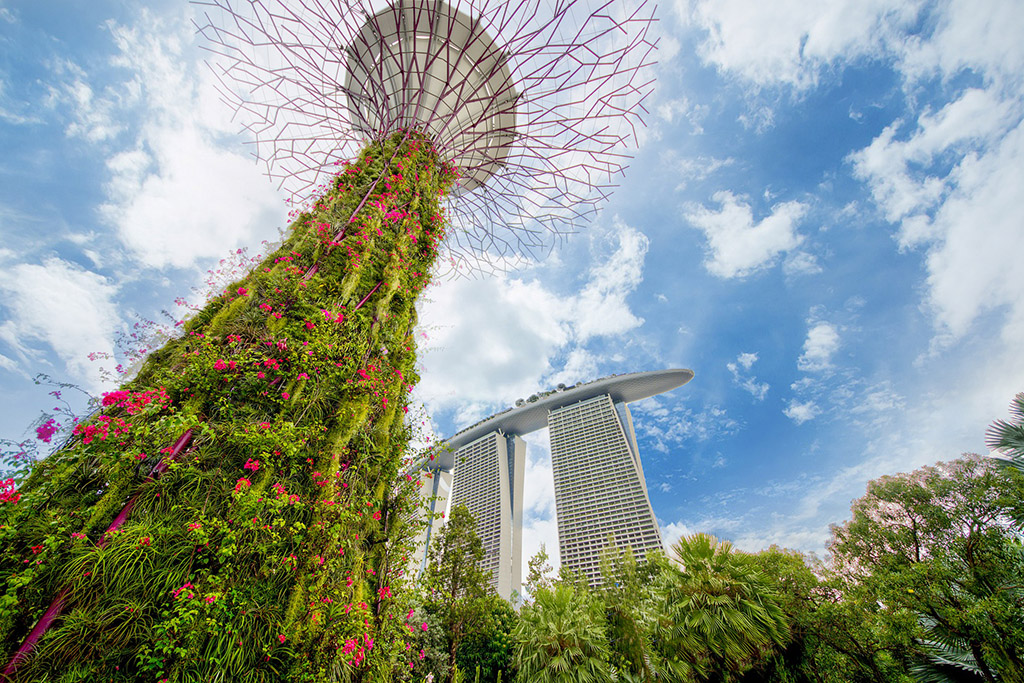
City-state – originating in late 19th century England, this term has been applied to the early world’s superpowers such as ancient Rome, Carthage, Athens, and Sparta. Today, Monaco, Vatican City, and, obviously, Singapore are considered the world’s only true microstates.
Although Singapore is relatively small, this powerful city-state has a lot to offer so that especially first-timers will cherish this helpful guide.
Welcome to Singapore – My Bumpy Arrival
My very first trip to Singapore was actually just a three-day-detour during a road trip to Malaysia.
Malayan bus drivers are a very unique breed. They might be wearing just a torn T-Shirt and driving in broken flip-flops. There is no need for them to dress to impress since secretly, they rule the country. They are the Kings – at least of the roads.
At the bus stop, they sashay by the waiting passengers without so much as looking at them, let alone greeting or answering a question. They grudgingly open the trunk and command this contemptible lot with a silent motion to put their dunnage in there.
What do you mean, there is a puddle of motor oil in there?
Put your stuff in, I don’t have all day.
They show this bunch who runs the show.
Let’s Hit the Road
As soon as everybody has taken their seats, the King gets the motor running and off he goes crossing his kingdom. Obviously, he has to inform his queen thusly because he takes out his phone and has a good natter only pausing by answering his other phone from time to time. Or by lighting another cigarette.
Over his head, a plaque with a crossed-out cigarette might be interpreted as no smoking.
But who are you, subject, to tell the King what to do?
It was pretty much like this when I took the afternoon bus from Kuantan on Malaysia‘s East Coast to Singapore.
The bus was about half full, the driver in a great mood talking to what seemed to be a colleague. Smoking like a chimney.
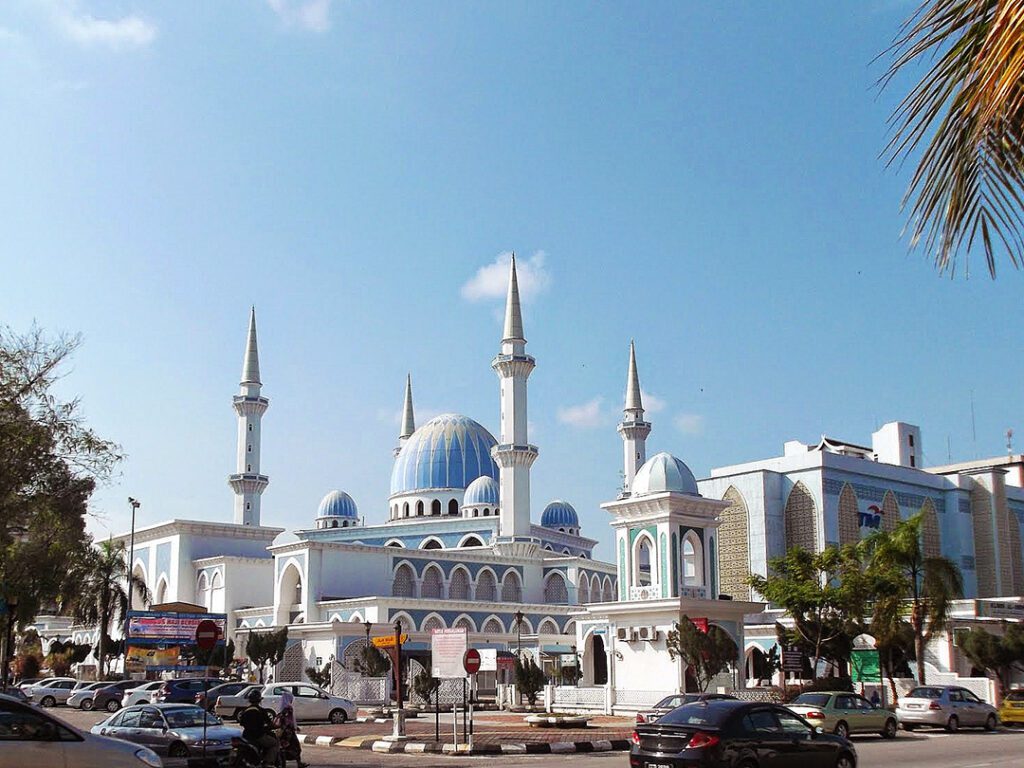
These guys were the only ones with warm jackets. No wonder he had to turn the air conditioner up as high as possible.
Everybody else was freezing.
Everybody else were passengers, so who cares?
I was quite a newbie to Malaysia and the system of secret emperors. Therefore, waveringly moving from seat to seat, I went up front to tell him that it was really, really cold. To emphasize my words – his English seemed as rudimentary as my Bahasa – I wrapped my arms around myself and shivered. Brrr.
He was delighted! Laughing and laughing. He loved my little pantomime and kept repeating ‘Brrrr’. And then he laughed and laughed.
Albeit, he did not turn the air condition down.
The King and I
Johor Bahru is the last stop before you cross the border to Singapore, and there everybody else got off. We were alone – the King and I.
I took the liberty to ask him if there was an ATM or an exchange booth at the border since I had only Malayan Ringgit. From his reluctant snarl, I understood that there wasn’t any.
I asked him a couple more questions such as where exactly are we going, what time will we approximately arrive, will there be an ATM there. There, wherever we arrive at whatever time.
He didn’t bother to answer even one of them, instead, he kept on smoking. Since I was sitting behind him now, practically sharing the smoke with him, I impishly pointed at the crossed-out cigarette Dilarang Merokok! – smoking is prohibited.
As I explained in an earlier post, babbel.com arms you with a load of helpful vocabulary. Although in this case, it didn’t help. He cracked up laughing, repeating ‘dilarang merokok!‘ as if it was the most absurd joke ever and kept on merokok.
A Complex Borderline
We got to the border. He stopped the bus and said things in incomprehensible English. I looked at him questioningly, he kept repeating, we didn’t get any further.
Fortunately, an officer showed up and explained the drill. I had to get into the building where the Malay would stamp my passport. Be that as it may, I had to take all my belongings with me.
The bus would wait on the other side.
It was shortly before midnight. There weren’t any other people besides those who had to be there because it was their job.
I schlepped my backpack and my bag up the stairs, entered a huge, now empty hall with a row of booths.
I got my passport stamped at the nearest booth. After wishing the stamping lady a good night, I schlepped all my stuff down other stairs to the bus.
Don’t Leave Me This Way
We drove for about three minutes and arrived at the Singaporean side of the border.
Same drill – off the bus with all my luggage in tow, up the stairs, stamp, good night, down the stairs, to the bus.
But there was no bus.
There was a line of curbs, but no busses.
I sat down on one of the benches, tired, being a bit frustrated that everything took so long. No bus.
After about twenty minutes, it dawned on me that maybe I was waiting in the wrong spot. The grouch probably waited for me somewhere else.
I went back to the border. Between two traffic lanes was a channeling island with a booth. In the booth was a lady – who was pretty unhappy that I entered her island.
Which Way to Go?
“You’re not allowed here, it’s dangerous!” she shooed me away after she confirmed that there were only these curbs where the busses are waiting for their passengers.
So I logged all my stuff back to the bench and kept waiting. Slowly I didn’t believe that the guy would ever show up. He probably was already laying on the bedstead in his King driver’s castle.
The longer I waited, the clearer was the picture. He had been annoyed by all my ‘brrr‘ and ‘dilarang merokok‘ talking. Clearly, the driving potentates aren’t used to the subjects’ complaints or backtalking.
So he had taken advantage of the fact that I was his only passenger and just split.
Left me stranded.
In the middle of the night at the border of a foreign country.
Knowing that I didn’t have any of the local currency.
I went back to the island. The lady in the booth was surprised to see me again. Since I was in such distress, she didn’t even snap at me for joining her in her enclave again.
There weren’t any cars at this time of the night, anyways.
Give Me Your Tired, Your Poor…
Hence, she took me to the stop for the local buses and explained my situation to the bus driver – a real hottie, nothing like the villain that abandoned me.
The hottie agreed to let me ride with him for free.
Obviously, I had no idea where I was, I didn’t know where he would take me, and if I knew, I didn’t know how to get to my hostel, anyway. It was about 2 a. m., I still didn’t have one Singaporean cent.

(Photo: Jeriel Lim from Singapore, A’Land Express Scania K124IB (Gemilang) (33573460708), cropped 3:2, CC BY-SA 2.0)
Nevertheless, we already arrived. Somewhere. At the final stop. His final stop, definitely not mine.
Okie Dokie, so we’re….here. Thanks, terima kasih banyak.
“There are taxis over there”, pointed the hottie. He was not only hot, but he was also right, there was a cab.
The Kindness of Strangers
“Are you taking credit cards?” “Only visa”, answered the overly friendly cab driver. “That’s fine. Please, take me to Rucksack hostel on Hong Kong Street.”
The challenging journey was about to end, what a relief.
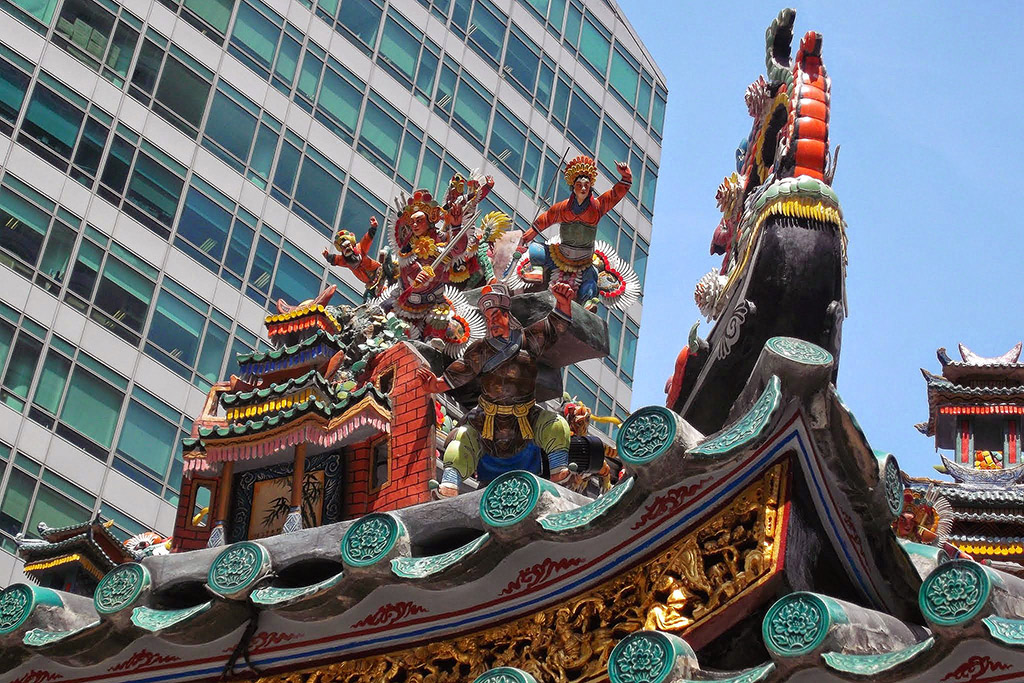
Hong Kong Street is – you might have guessed – at the outskirts of the old Chinese neighborhood. Left and right old narrow row houses, about three storeys high. Very cute.
The Rucksack hostel was painted in red and the nice man stopped right in front of it. He told me the price, I handed him my credit card, he put it in the slot, then, the little machine wrote him on the display that the card declined. This happens sometimes, to me, to you, normally it’s no big deal. But at this moment – I was not only beat. I also felt beaten.
He was so friendly to try again twice, but nope, for some reason, the stupid machine and my stupid card were not willing to cooperate. “It’s fine, you don’t have to pay”, said this sweet, sweet man. “No, I don’t want that. Wait, I have Euros somewhere.” “No, really, it’s fine”, he insisted. “No, wait a sec, here you’ve got 10 Euro. At least with the change, I’ll have some Singaporean money”, I imposed the crinkled tenner on him.
Team Rucksack
While I typed in the code to unlock the hostel’s entrance door, I felt a bit bad. I had the feeling of having insulted the driver by refusing his generosity. But I would have felt bad taking advantage of his kindness.
Oh dear, what a day!
And then it was a small sheet of paper that comforted me and made me forget the mean driver and the hodgepodge and the nice but snubbed driver. It was a little welcome note that I found at 3 a. m. at the door of my room at this lovely hostel.
And you bet, I had a good sleep!
Singapore’s History
British Trading Post
The island that today is Singapore was previously inhabited by only 20 Malay fishing families. Also, it was a haven for pirates.
In 1819, Sir Thomas Stamford Raffles, a commercial agent of the British East India Company, arrived in Singapore in order to establish the first local branch. By 1824, the company possessed the entire island. They paid the Sultan of Johor a lump sum of $ 60,000 and then an annual pension of $ 24,000.
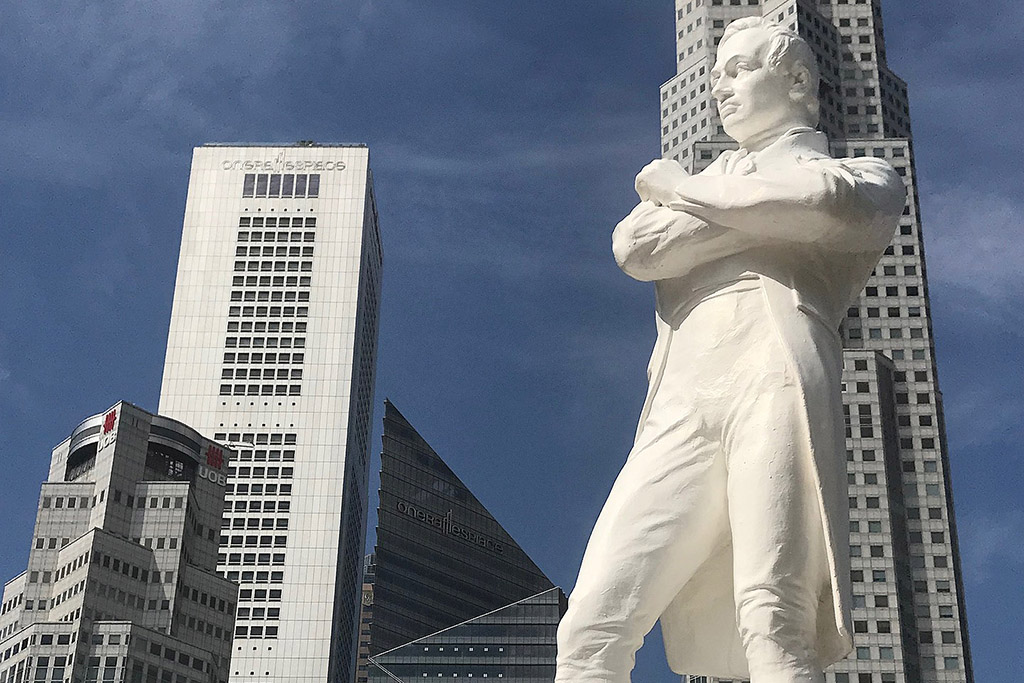

Together with Penang, Malacca, and Labuan, Singapore became the Straits Settlements in 1826 and in 1836 their capital. Eventually, the Straits Settlements became a British crown colony.
Due to its geographical location along the busy shipping routes between China and Europe, Singapore’s importance as a transshipment port grew rapidly.
World War II and Independence
During World War II, troops from Japan invaded Malaysia and pocketed the island of Singapore. Despite their numerical superiority, the insufficiently prepared British, Australian, and Indian soldiers surrendered in 1942.
After the Japanese capitulated in September 1945, Singapore came back under British rule. The island became a self-governed crown colony in 1959. The first elected prime minister was Lee Kuan Yew.
After a referendum, Singapore was released into a federation with Malaya, Sabah, and Sarawak and thus became independent from the United Kingdom in 1963.
Singapore was later excluded from the federation after domestic unrest and ideological conflicts. The Malaysian government was afraid the unrest could spread across the border. In 1965, Malaysia became the first state to recognize Singapore’s sovereignty.
However, the young and territorially restricted nation had to fight for its economic independence and faced problems such as mass unemployment, housing shortage, lack of arable land, and raw materials. Nevertheless, by 1990, Singapore made the leap from a developing country to an industrial nation within just one generation.
Becoming a Powerful City-State
After early years of turbulence, and despite a lack of natural resources and a hinterland, the nation quickly developed into one of the four Asian tigers based on foreign trade and became a highly developed country.


Singapore is the only country in Asia with an AAA country rating from all major rating agencies. It is a major finance and shipping hub and also ranks high on key social indicators such as education, health care, quality of life, personal safety, and public housing. Also, Singaporeans enjoy one of the longest life expectancies in the world, the fastest internet connection speeds, and one of the lowest child mortality rates in the world.
All That Glitters…
Since its independence in 1965, Singapore’s politics have been ruled in a one-party system by the People’s Action Party (PAP). The PAP is accused of rigid actions against the opposition parties and to get unpleasant opponents out of the way through defamation in civil lawsuits. Also, restrictions in public and private life cannot be denied. Hence, Western democracies consider Singapore’s form of government closer to authoritarianism than to democracy.
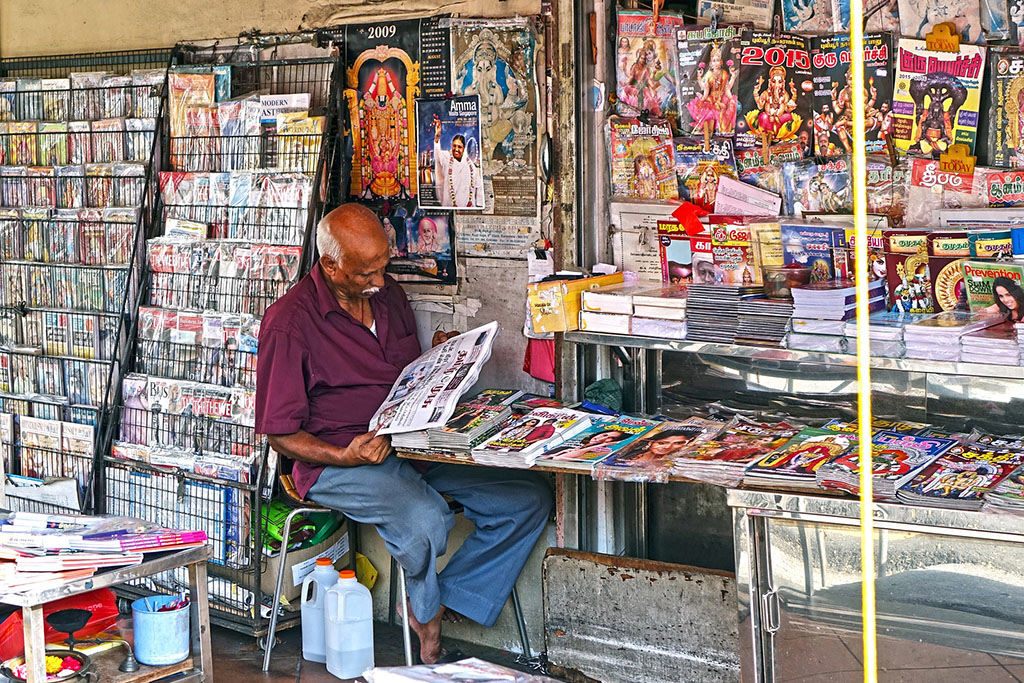

Experts criticize the authoritarian state system which, for example, requires a state license if more than three people want to speak publicly about politics, religion, or internal affairs of the state.
However, due to Singapore’s limited space, institutions and different religions are found close to one another. Buddhist and Hindu temples, Christian churches, and Islamic mosques are partly next to each other.
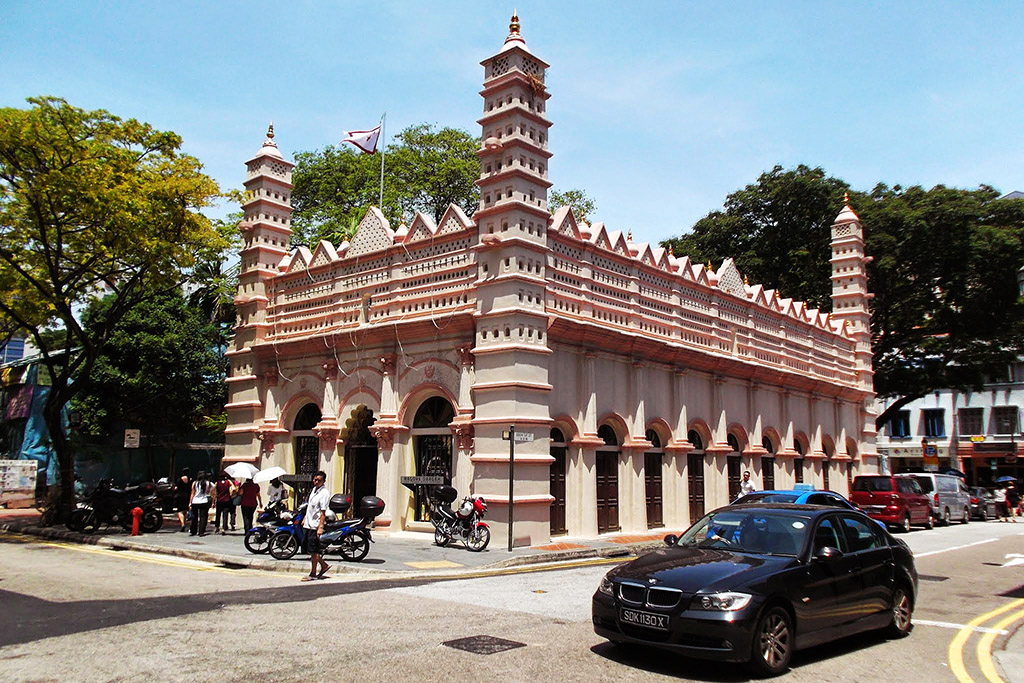

Obviously, this peaceful coexistence is the result of a mutual effort to gain and preserve equality and mutual respect. Peaceful coexistence is partly determined by the state. For example, there is social housing through so-called ethnic group quotas among Chinese, Malay, and Indians.


With 33 percent, Buddhism is most widespread in Singapore, however, followed by 19 percent Christians, 14 percent Muslims, 10 percent Daoists, and 5 percent Hindus.
Five Most Vibrant Neighborhoods
More than eleven million foreign tourists visit Singapore every year. This makes the powerful city-state one of the ten most visited cities in the world. Give me the pleasure to guide you through the most exciting districts.



Soon after his arrival in Singapore, Thomas Stamford Raffles laid out the location and appearance of the districts for the ethnic groups. He also ordered the construction of so-called shophouses, hence business premises with a covered walkway below and apartments above, as he knew them from the island of Penang in northern Malaysia.
So to explore Singapore in a comprehensive way, it’s actually a good plan following his layout. This way, you’ll get a feel for all the different cultures and ethnicities in a nutshell.
Fort Canning and Singapore’s Colonial Past
The Fort Canning Park on the Bukit Larangan hill is part of the old colonial quarter.
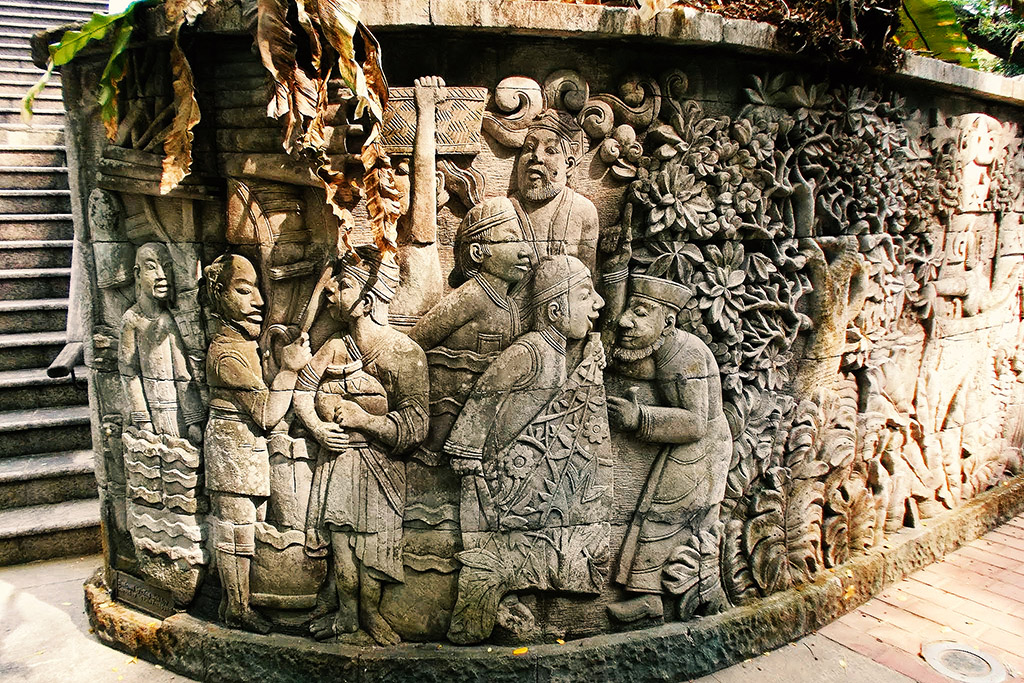

The park is home to the Fort Canning Center, the Fort Canning Service Reservoir, the city’s oldest Christian cemetery, the ASEAN Sculpture Park, the Battle Box bunker from WWII, two Gothic gates, and also the city’s first botanical garden from 1822.
Also, Stamford Raffles built his house on Bukit Larangan in 1823.
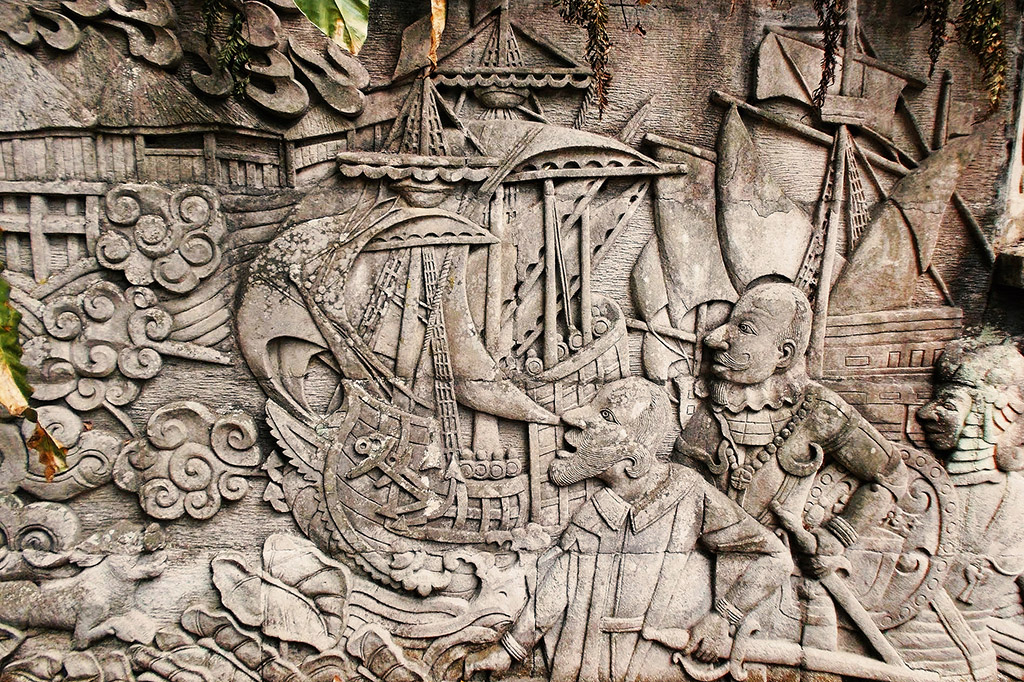

Walking from the park’s southeast corner past the Old Hill Street Police Station, you’ll get to the Old Parliament House. Built in 1827, it is the oldest government building and perhaps the oldest surviving building in all of Singapore.


(Photo: Photo by CEphoto, Uwe Aranas or alternatively © CEphoto, Uwe Aranas, Singapore Former-Hill-Street-Police-Station-01, cropped 3:2, CC BY-SA 3.0)
The Old Parliament House was home to the Parliament of Singapore from 1965 to 1999.
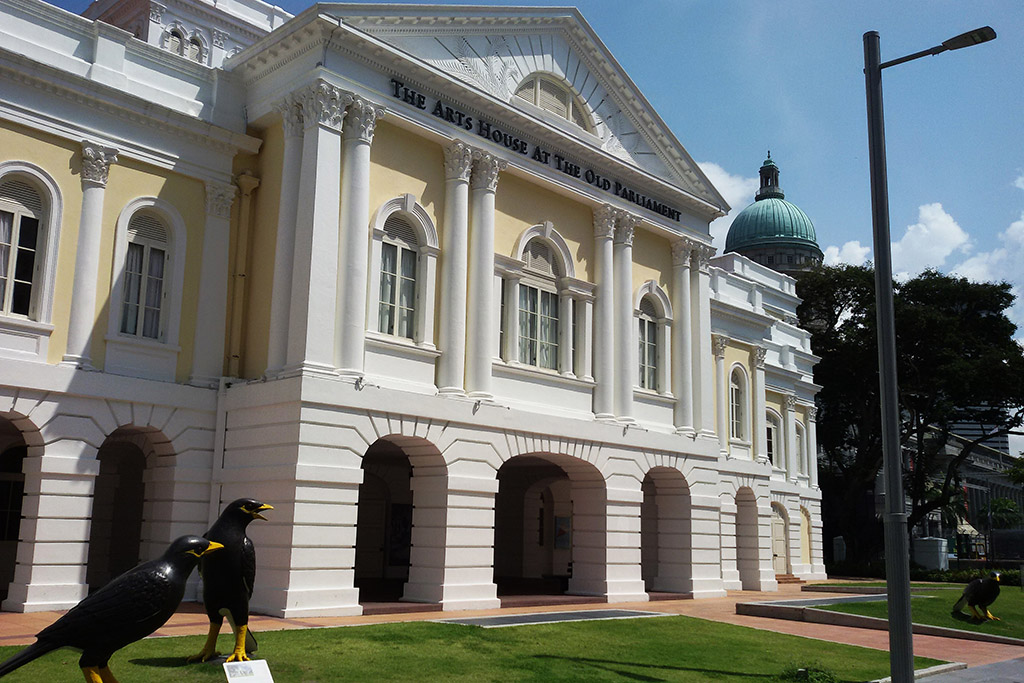

It is now called the Arts House and serves as a multi-disciplinary arts venue.
Singapore’s Cradle
The building’s river frontage was also where Sir Thomas Stamford Raffles set foot on Singapore’s soil in 1819.
Raffles then persuaded Temenggong Abdul Rahman, a noble from the Johor Sultanate, to move to Telok Blangah since he planned to use the terrain for public and administrative purposes.
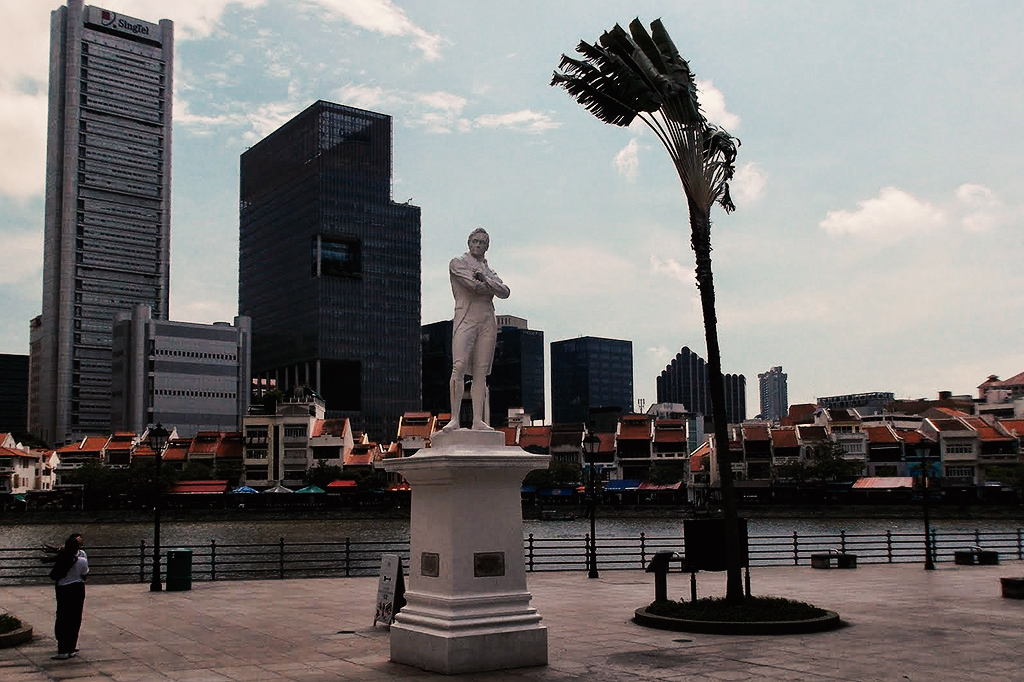

Across from the Arts House stands the Victoria Theater and Concert Hall. It is housed in the former City Hall and shows a high and distinctive bell tower
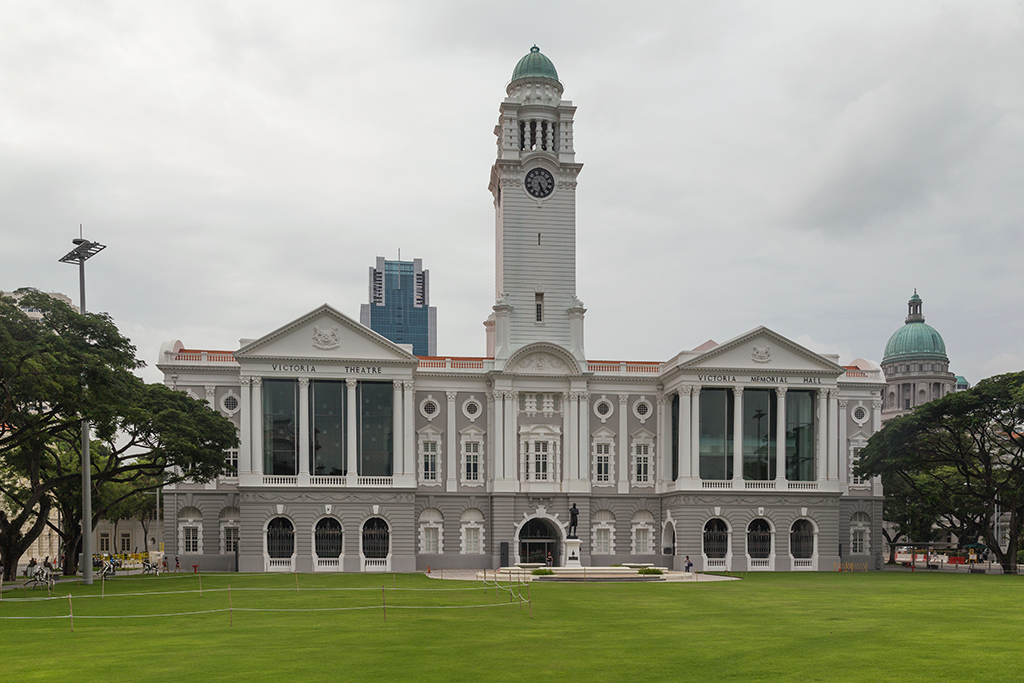

(Photo: Photo: Marcin Konsek / Wikimedia Commons / CC BY-SA 4.0, 2016 Singapur, Downtown Core, Teatr Wiktorii i Hala Koncertowa (02), CC BY-SA 4.0)
Crossing the greenery called Empress Lawn, you’ll get to the Cavenagh Bridge dating from 1870.


This suspension bridge over the Singapore river grants scenic views of the historic old part as well as modern skyscrapers – and, of course, of the river.
British Heritage
As you cross the Cavenagh Bridge, you stand right in front of the memorable Fullerton Building. Built in a Neoclassic style, it was originally Singapore’s General Post Office Building. Named after Robert Fullerton, the first Governor of the Straits Settlements, it is today one of the city’s most luxurious hotels.


To continue our walk through Singapore’s historic district, cross the river over the Anderson Bridge. It was designed in a distinctive white metalwork in 1910.
From here, the Queen Elizabeth Walk leads you across the Esplanade Park. This greenery was actually installed in 1943 as Singapore was ruled by Japan. This makes the Esplanade Park one of the oldest parks in all of Singapore. Logically, there are many historical landmarks to be seen such as the former Indian National Army Monument, a Cenotaph, the Tan Kim Seng Fountain, and the Lim Bo Seng Memorial.
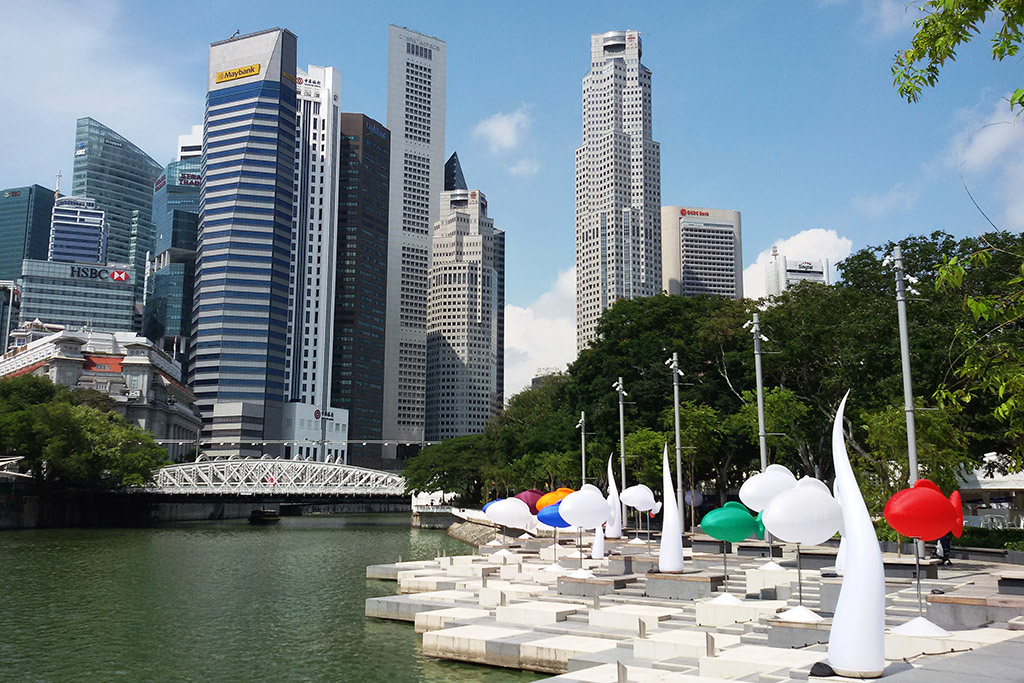

One block north of the park is one of Singapore’s most iconic buildings.
Singapore’s Icon
The Raffles Hotel was founded by the four Armenian brothers Sarkies. In 1887, they opened a colonial-style villa with ten rooms. Over the years, the hotel has been expanded several times. Also, they added a veranda, a ballroom, a bar, a billiards room, and further buildings and halls.


(Photo: Elisa.rolle, Raffles Hotel 2012 0076, CC BY-SA 4.0)
The hotel survived World War II and the Japanese occupation of Singapore unscathed. Albeit, it served as a transit camp for prisoners of war towards the end of the war.
The Raffles Hotel is particularly famous for being the place where the last wild tiger in Singapore was killed in August 1902.
Also in the early 20th century, barkeeper Ngiam Tong Boon invented the Singapore Sling. This fancy cocktail was sipped by the hotel’s famous guests
like Charlie Chaplin, Jean Harlow, Joseph Conrad, Rudyard Kipling, Somerset Maugham, Ava Gardner, Elizabeth Taylor, and, of course, Queen Elisabeth II.
In 1987, the Singapore government declared the Raffles Hotel a national monument. It is the flagship of the Raffles International hotel chain and obviously famous for its luxurious accommodations and fine dining. The building has a tropical courtyard, a museum, and also a Victorian theater.
Shop Till You Drop
The city-state of Singapore has incredible 171 shopping malls, and the Raffles City Shopping Center across from the hotel is one of them.
I’m not a big shopper when I travel, however, since Singapore is such a shopping paradise, I’m informing you that there is the famous shopping street Orchard Road about 3 kilometers west of the Raffles. If you don’t want to walk there in about half an hour, you can also hop on the MRT North South Line at the stop City Hall and get off after three stops at the stop Orchard.
Enjoy making your credit card glow!
Chinatown
The famous Chinese traveller Wang Dayuan visited Singapore, which then went by the name of Temasek, in 1330 and recorded that already then, there was a Chinese community.
As a matter of fact, the comparatively large Chinese district is of significant historical and cultural importance in the development of today’s powerful city-state of Singapore. Therefore, large parts have been declared a national cultural heritage.
According to the Raffles Plan of Singapore, the area was originally planned to be a subdivision of the colonial district. He gave instructions to divide the area into a colonial city with major commercial establishments, as well as inherent divisions for the Bugis, Arabs, Indians, Malaysians, and Chinese.


Supposedly, the tooth relic was found in a collapsed stupa. With 7.5 centimeters, the tooth is actually far too long for a human tooth. The relic is on display on the temple’s 4th floor.
Since Raffles assumed the Chinese would be by far the largest part of the community, he used all of the land southwest of the Singapore River for their housing
Howsoever, Chinatown was soon overcrowded and remained so until the relocation of residents by the government’s housing agency in the 1960s.
Yet, in the heart of this Chinese community is an important temple for Singaporean Tamils, the Sri Mariamman Hindu Tamil Temple. Also, there are the Al-Abrar Mosque on Telok Ayer Street and the Jamae Mosque on Mosque Street. This only proves that despite Raffles’ efforts to separate the early immigrants, they had no qualms about living side by side.
Chinatown Heritage Centre
There is a fantastic place to trace the history of Singapore’s Chinese population. Located in three remodeled shophouses on Pagoda Street is the Chinatown Heritage Centre.
Here, the story of Chinatown’s earliest residents is retraced and documented. Beginning with their journey when they left their villages in China to escape famine and civil unrest to mean a better life in Singapore.
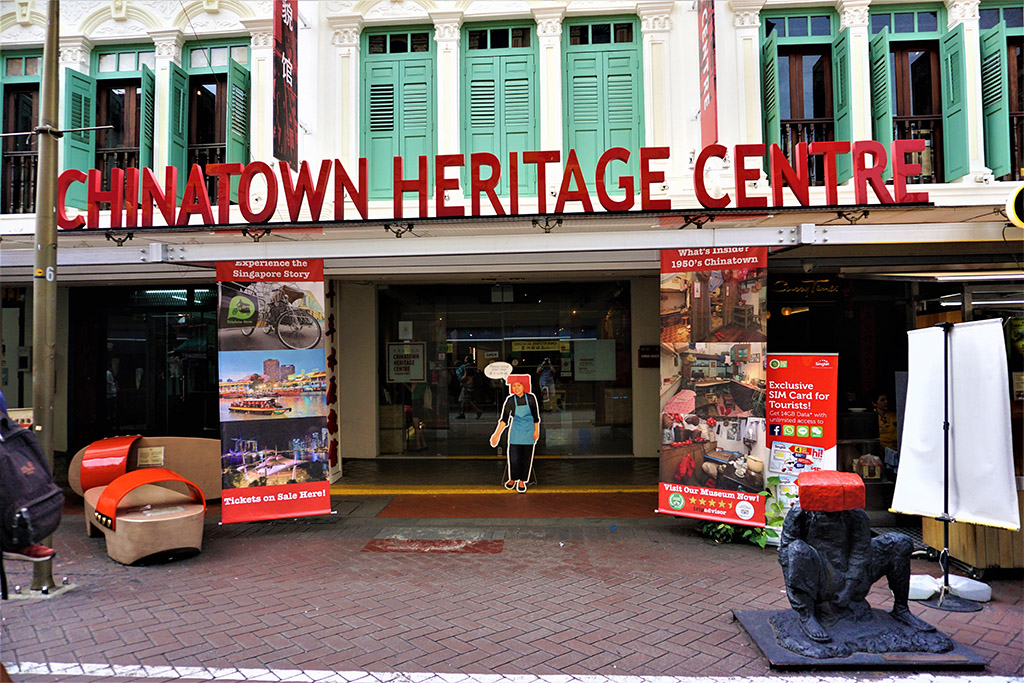

(Photo: Joyofmuseums, Chinatown Heritage Centre, Singapore – www.joyofmuseums.com – external, CC BY-SA 4.0)
In six galleries, you step back in time and get insight into the lives of these traders and laborers. Immerse in their past experience through a range of multi-sensory and interactive exhibits.
Chinatown Heritage Centre
48 Pagoda Street
Singapore 059207
The museum is open every day from 9.30 a. m. to 6.30 p. m. and admission is 18 SGD.
They also have a nice gift shop and a cozy café.
Thian Hock Keng Temple
In 1821, Chinese immigrants from Fujian Province erected a small place of prayer on the site of today’s temple. They dedicated it to the sea goddess Mazu, the patroness of seafarers.
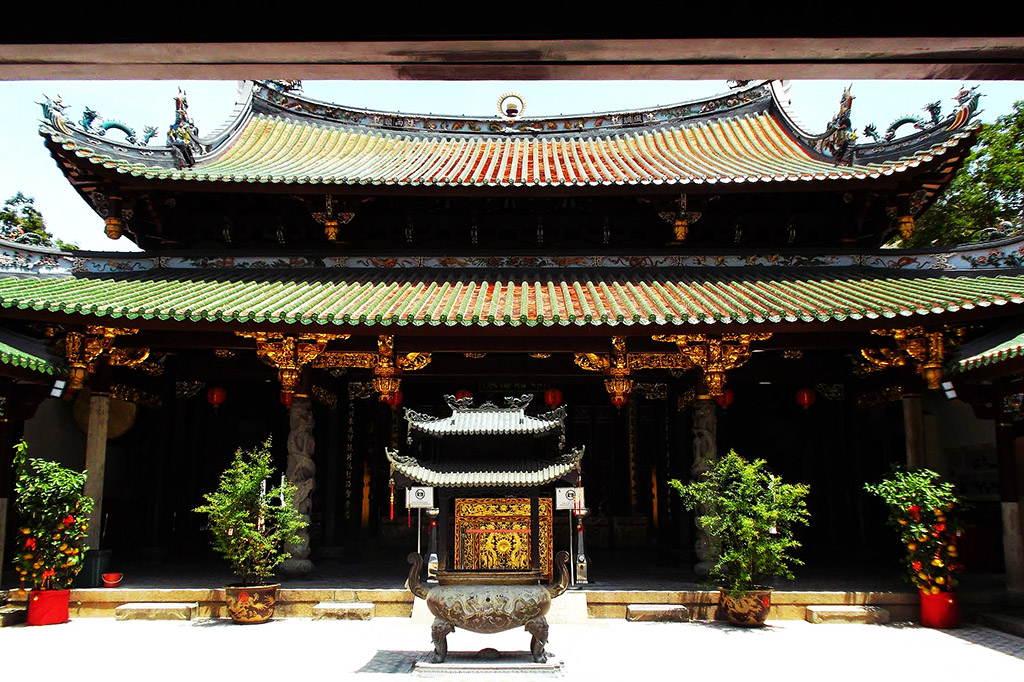

Chinese craftsmen built the temple in traditional Hokkien architecture. They didn’t use one single nail for the construction and also imported all materials from China. This included the ironwood posts supporting the building.
Jamae Mosque
Masjid Jamae is one of the oldest mosques in Singapore, albeit, located right in the Chinatown district. Established in 1826, among the Tamil Muslim community, this mosque goes by the name of Chulia Mosque or Periya Palli.


It was the Chulias, hence Tamil Muslims from South India who founded the Jamae Mosque. The Chulias came to Singapore mostly as traders and money changers. However, within a very short period of time, they set up three mosques. Apart from Jamae Mosque, there are also the Al-Abrar Mosque and Nagore Durgha in close proximity at Chinatown.
In the predominantly Chinese location, the Jamae Mosque and its neighbor, the Sri Mariamman Temple, definitely do stand out and therefore underline Singapore’s multicultural spirit.
Sri Mariamman Temple
This brings us to the Sri Mariamman Temple. It is the city-state’s oldest Hindu temple and built in 1827. It was designed in the Dravida style and dedicated to the mother goddess Mariamman, especially venerated in southern India and northern Sri Lanka.
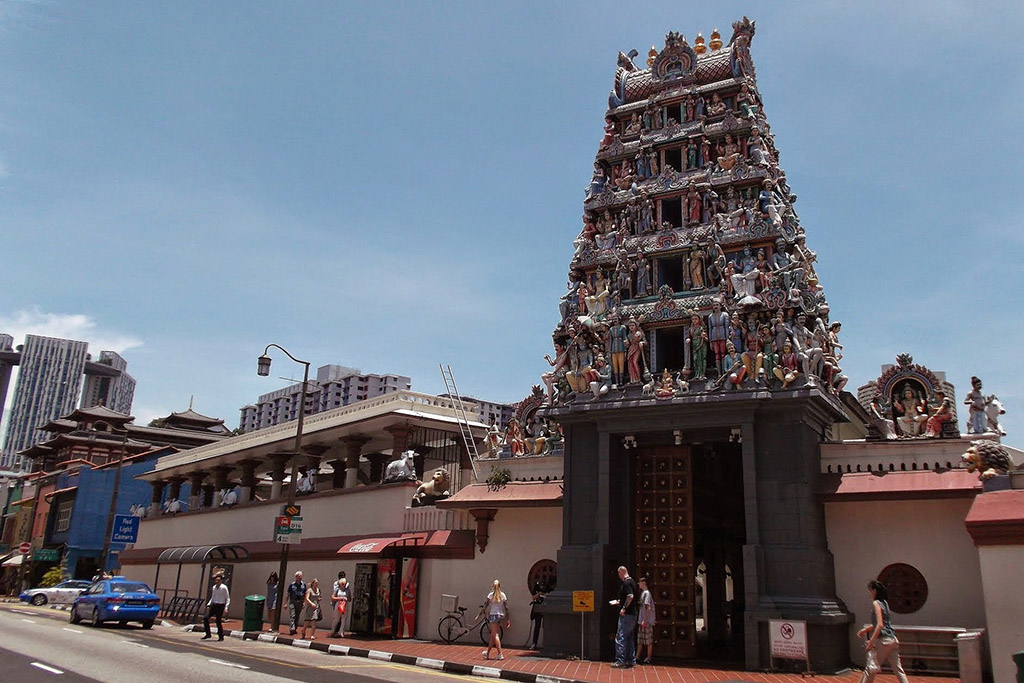

The first simple construction was made from wood with a palm leaf roof. Over the years, the temple was improved and enlarged, made possible through donations. The original three-story gate tower was replaced by today’s five-story tower in 1925.
Great Souvenir Shopping
Mosque, Pagoda, and Temple street as well as all the crossing lanes and alleys are lined with shops bursting with beautiful, fun, useful, and quirky items and gadgets – made in China, obviously. Apart from Singapore’s 171 malls, this neighborhood is a shoppers’ paradise – so don’t you miss it!
Little India
While there is this Indian token right in the heart of Chinatown, there is, obviously, also an Indian neighborhood. It goes by the name of Little India and is north of Chinatown.
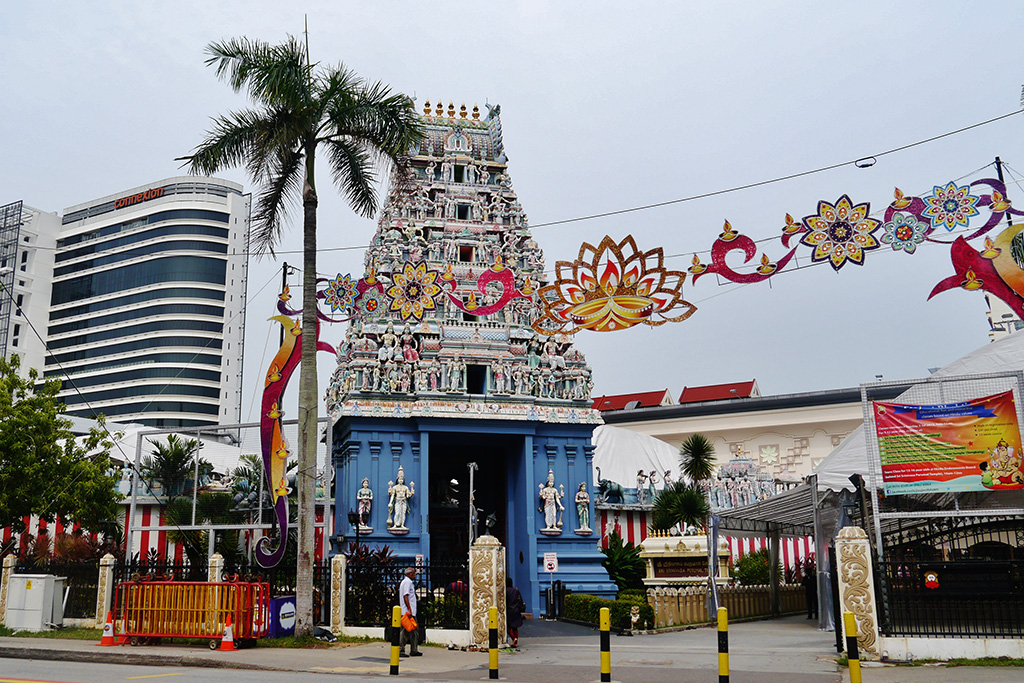

(Photo: Zairon, Singapore Tempel Sri Srinvasa Perumal Gopuram 1, cropped 3:2, CC BY-SA 4.0)
The Indian immigrants originally settled further south on Chulia Street. Actually, Chulia derived from Chulier, hence, residents of the old Chola empire in Tamil Nadu. They migrated to many parts of the Malay Peninsula. However, due to the increase in population, the Chulia had to resettle towards Serangoon Road from the 19th century on.
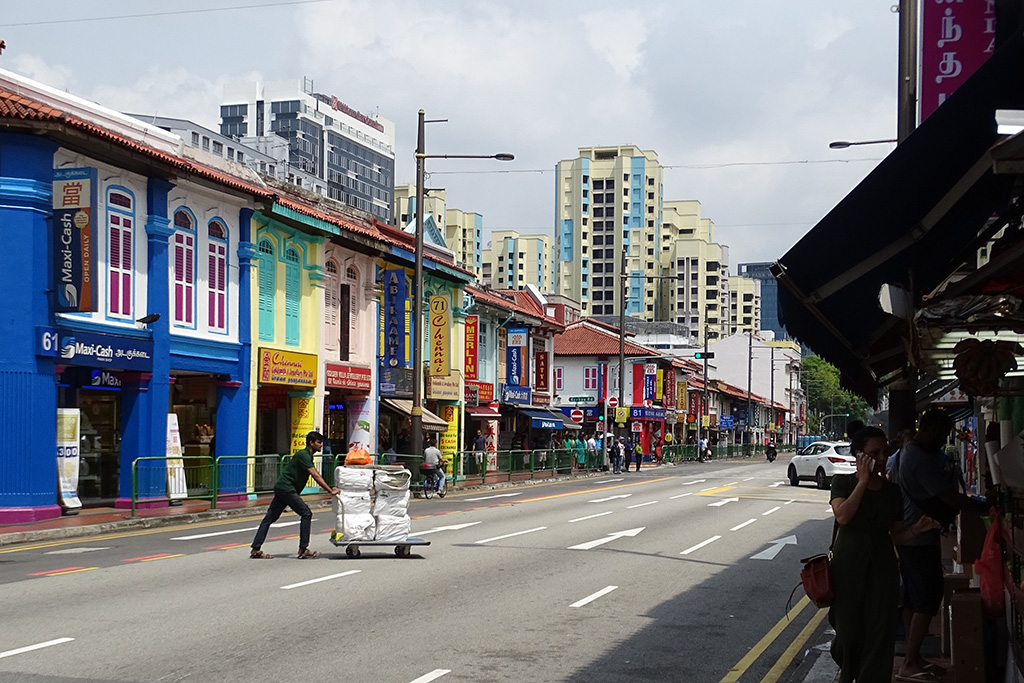

(Photo: -jkb-, Little India Singapore 4, cropped 3:2 – landscape format, CC BY-SA 3.0)
As a matter of fact, Serangoon Road is one of Singapore’s oldest streets where you can find for instance the Sri Srinivasa Perumal Temple. Built in 1885, it is one of the city-state’s oldest Hindu temples.
Buffalo Stance
However, in this so-called Kerbau district, livestock farming reached its peak around 1900. Kerbau, by the way, translates to buffalo. The Rochor Canal, dug in the early 19th century, boosted cattle breeding in Little India. Consequently, there were slaughterhouses and dairy dealers.
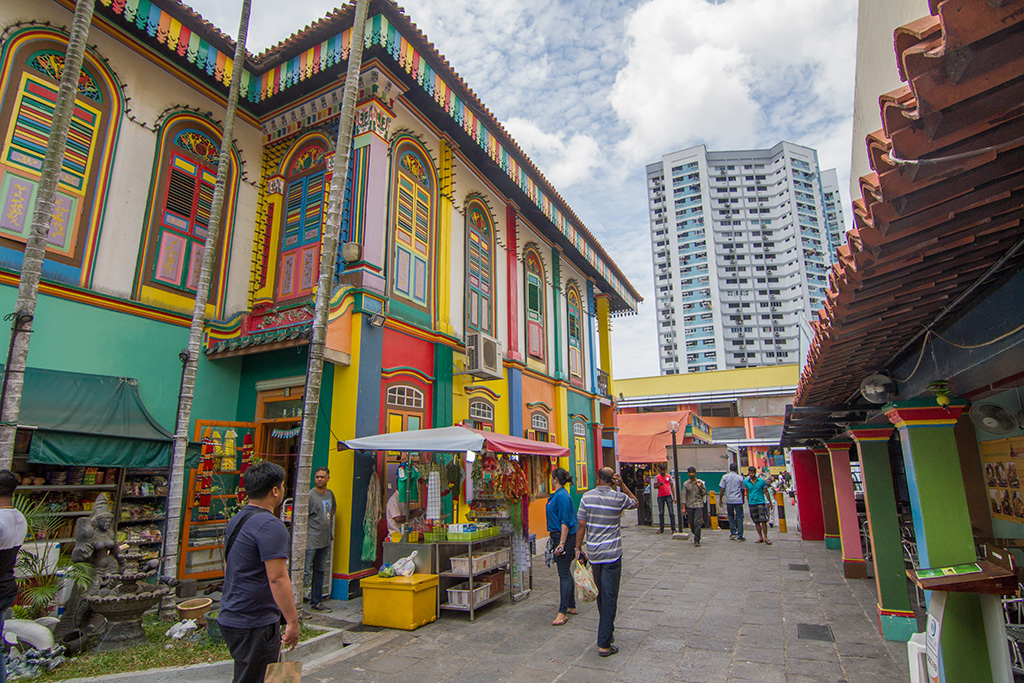

(Photo: Maksym Kozlenko, 2016-04-03 Kerbau Road, Singapore 13, CC BY-SA 4.0)
Since the buffalo herds were blamed for damaging the roads, the breeding activities were scaled back.


Yet, there were many sawmills and timber factories on the banks of the Rochor Canal. Hence, many Indians were hired to work in these trades.
Today, there are no cattle left. They were replaced by hotels and restaurants.
During Japanese bombing raids during World War II, the first bombs fell not far from Serangoon Road. The reconstruction after the war made Little India one of Singapore’s most famous tourist attractions.
One of the most impressive structures in Little India is the Sri Veeramakaliamman Temple. It has been dedicated to the Hindu goddess Kali. Actually, this makes total sense since this goddess has always been popular in Bengal, which, on the other hand, was the birthplace of the laborers who built this temple in 1881.


(Photo: Anandajoti Bhikkhu from Sadao, Thailand, 002 Gopura, Detail 1 (40423730782), CC BY 2.0)
Expectedly, inside, images of Kali depict her ripping out her victims inside out and wearing a garland of skulls. But there are also images of peaceful family moments with her sons Ganesha and Murugan.
It’s in the Mix
We’re in Singapore, so just like there are houses of worship from various denominations in Chinatown, there are also Mosques and Buddhist temples in the predominantly Hindu district of Little India.
For instance on Race Course Road is the small Leong San See Temple, built in 1917 by a Buddhist monk. It honors the Buddha Sakyamuni as well as Guanyin, the Chinese boddhisattva of mercy and compassion.
Both Taoists and Buddhists, practice their faith there.
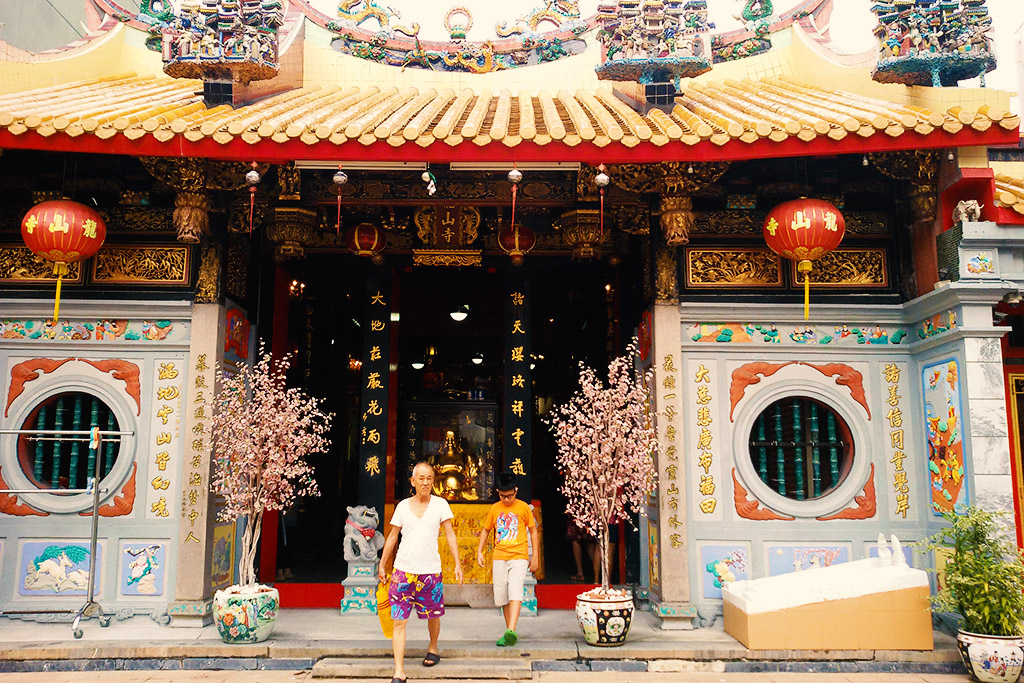

The temple is lavishly embellished with beams reproducing images of dragons, phoenixes, and floral ornaments. Various dragons are decorating the roof.
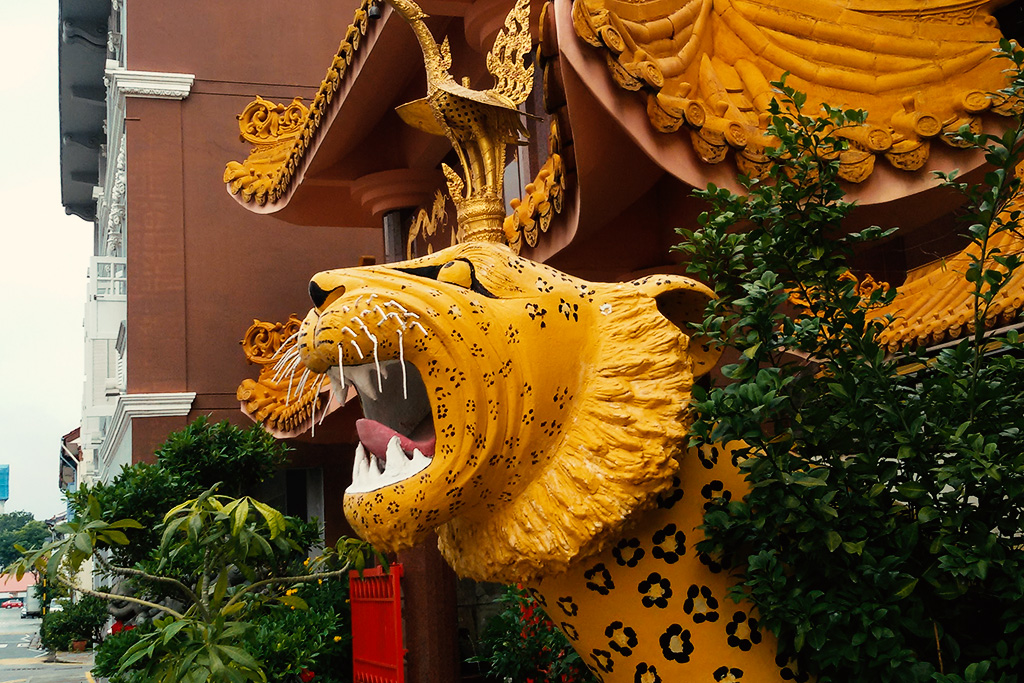

Just across the street is the Sakya Muni Buddha Gaya Temple. Thai monk Vutthisara founded this house of worship in 1927. The Sakya Muni Buddha Gaya Temple is one of the most important and popular Buddhist temples in Singapore.
There is a 15-meter-high seated Buddha statue as well as many smaller Buddha images.
Malay-Muslim Quarter
Prior to colonization by the British in 1819, today’s Kampong Glam was home to the Malay aristocracy.
As I explained above, under Raffles’ plans, the settlement was divided according to the different ethnic groups. Kampong Glam was designated for the Malay and Arab communities. Many of them were merchants.
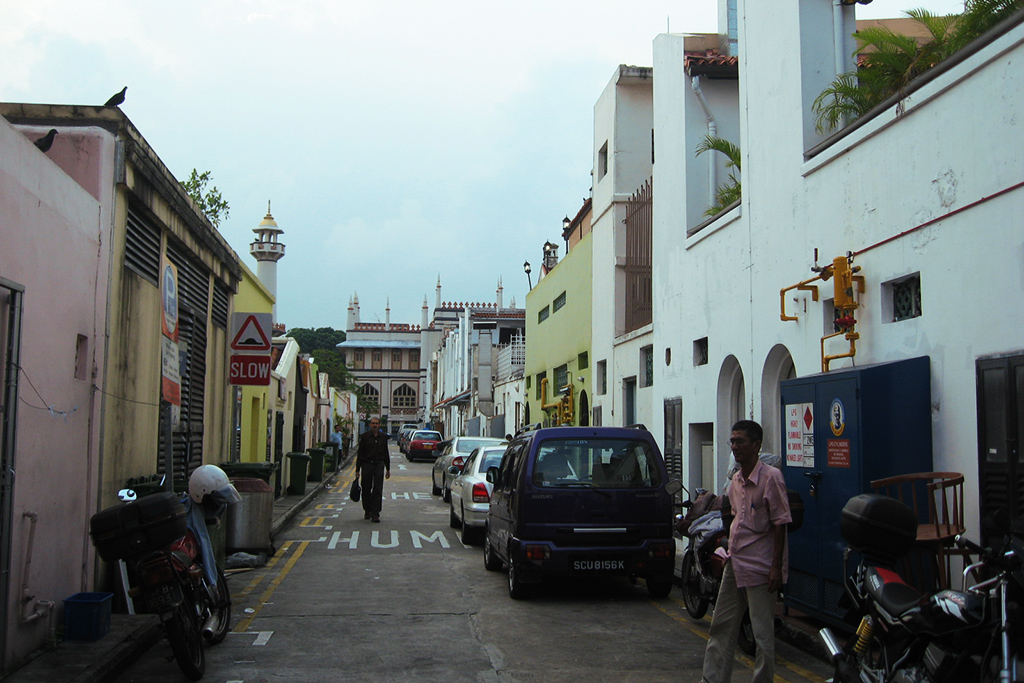

(Photo: Terence Ong, Lane in Kampong Glam, cropped 3:2/higher contrast, CC BY-SA 3.0)
To this date, Kampong Glam is Singapore’s Muslim Quarter. The area remains a center for Islamic activities. Also, the Sultan Mosque is a major landmark and, obviously, an important congregation point.
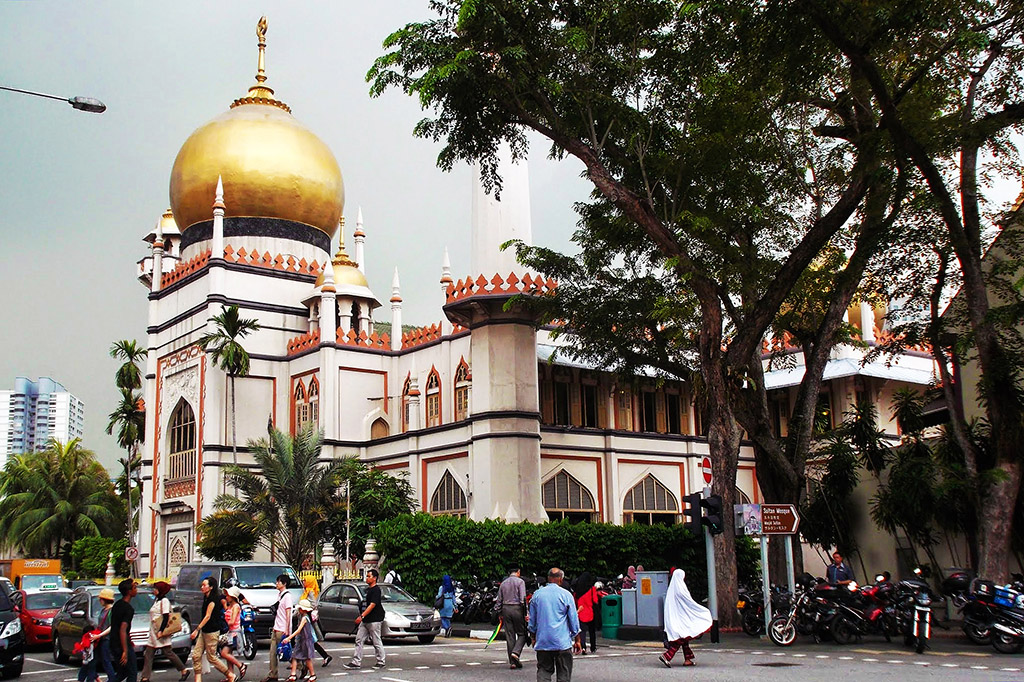

Just like Little India and Chinatown, Kampong Glam has been restored, too. Efforts were made to bring back its former color and vibrancy. Rows of shophouses are on Haji Lane, Arab Street, Baghdad Street, and Bussorah Street. However, many of today’s tenants are design and IT companies, art galleries, bars, and restaurants. Yet, they blend in just fine with the traditional businesses such as textile and carpet shops.
Bayfront
As you cross the bridges to the Fullerton Hotel, you are already very close to Singapore’s most iconic landmark, the Merlion. From there, you can easily continue walking around the Marina Bay. On this walk, you can admire some state-of-the-art constructions and innovative structures.
The Merlion
The Merlion is the symbol and allegory of the powerful city-state of Singapore. Obviously, the name is a composition of a mermaid and a lion. This mythical creature’s lion head symbolizes strength and fearlessness. The fish body, on the other hand, stands for the tight connection with the sea.
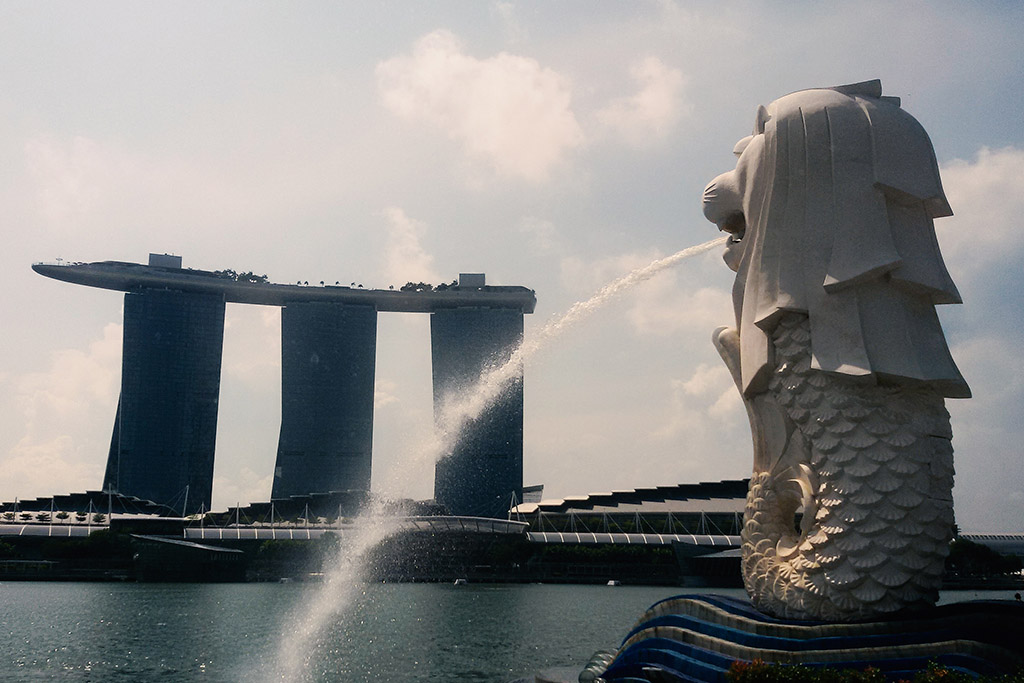

Alec Fraser-Brunner designed the Merlion for the Singapore Tourism Commission in 1964. Then, in 1972, Lim Nang Seng created the 8.6-meter-high statue.
Other statues are scattered across the city. Sadly, the 37 meters high accessible replica on Sentosa island was closed in 2019. It will be demolished due to remodeling activities on the island.
The Singapore Flyer
Crossing the Esplanade Bridge, turn right on Raffles Avenue. This way, you’ll pass by the Float@Marina Bay. It’s a floating venue for up to 9,000 spectators of sporting matches and concerts.
As you keep walking, you will certainly spot the Singapore Flyer. The construction of this Ferris Wheel is based on the London Eye. It has 28 gondolas and each one can hold up to 28 people,
With a height of 165 meters, the Singapore Flyer is actually the world’s second-tallest Ferris wheel. In 2008, it replaced the Star of Nanchang as the largest Ferris wheel in the world. It was then superseded by the High Roller in Las Vegas in 2014.
The wheel turns slowly and steadily without stopping for the passengers to get on. One rotation takes about 30 minutes.
For 33 SGD, you can hop on the flyer from Thursday to Sunday between 2 p. m. and 10 p. m.
The Helix Bridge
Parallel to the viaduct-like Benjamin Sheares Bridge, pedestrians can cross the Marina Channel over the Helix Bridge.
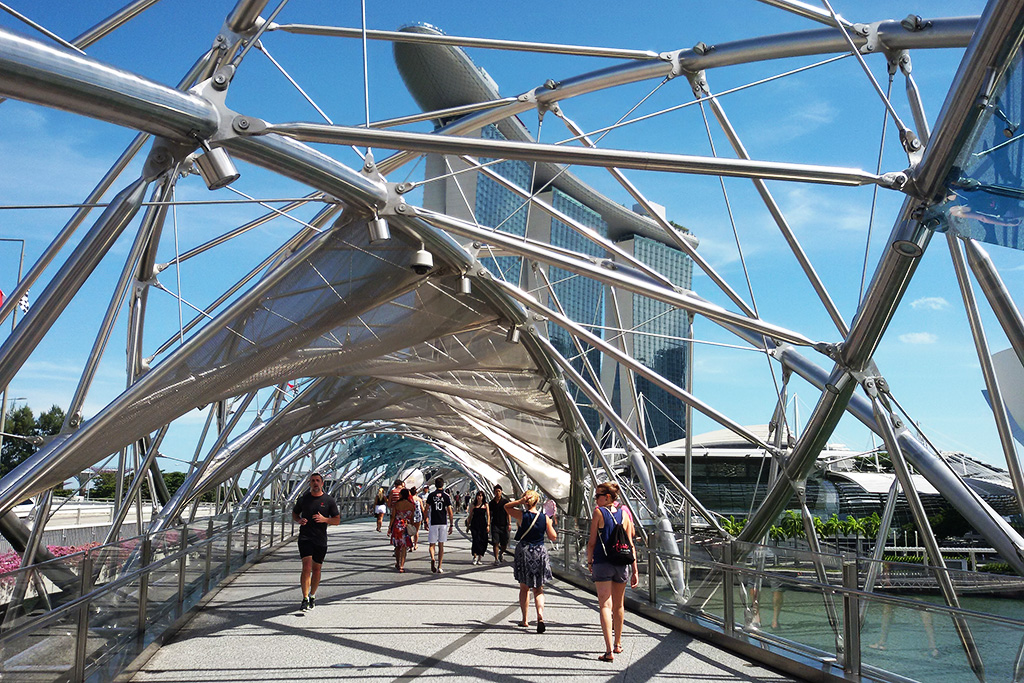

Canopies made of frit glass and perforated sheet metal along the inner spiral provide shade for pedestrians during hot summer days. The bridge has observation decks in four strategic locations. They offer an impressive view of the skyline of Singapore.
A series of lights illuminate the bridge at night. They highlight the structure of the double helix and thusly create a special visual experience for visitors.
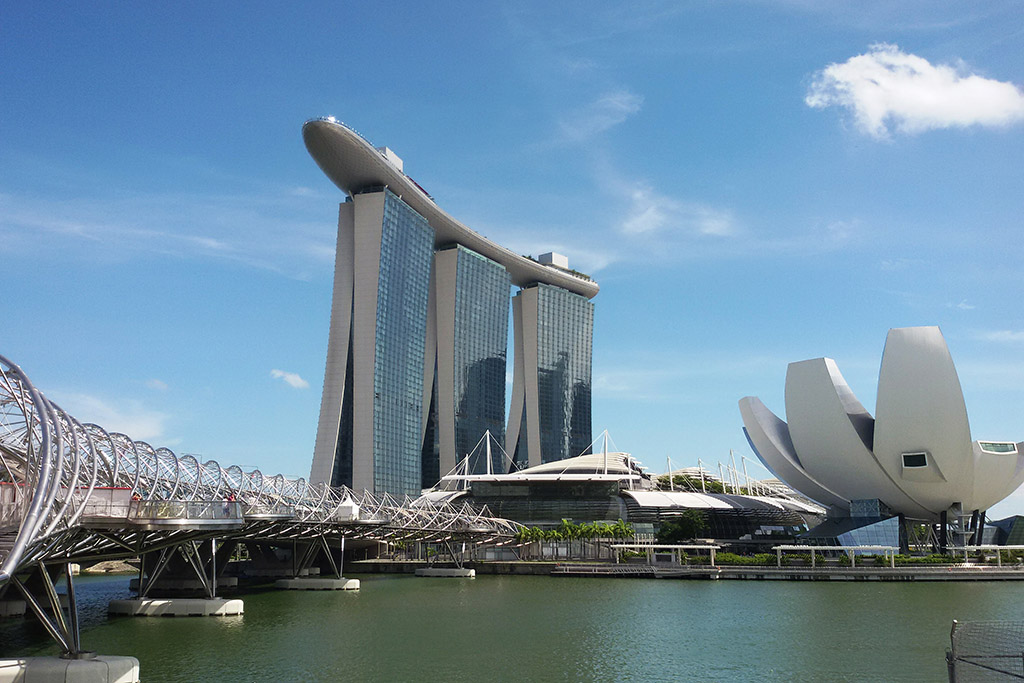

On the promontory right of the helix bridge is another amazing structure. Inspired by a lotus flower, the ArtScience Museum is anchored through a round base. From this center point, ten extensions protrude like gigantic petals toward the sky.
Rainwater is collected and channeled to the center of the building. It then flows through its concave roof to a lake at the building’s lowest level. The rainwater is then recycled for use in the building’s bathrooms
Read more about the ArtScience Museum in the museum section below.
Marina Bay Sands
Marina Bay Sands is a resort built by Las Vegas Sands and opened in 2010. The entire complex consists of a casino, the world-famous hotel Marina Bay Sands*, a conference and exhibition center. But, there is also a shopping center, an art and science museum, two theaters, bars and nightclubs, and also two floating pavilions.


Architect and Harvard professor Mosche Safdie designed the resort. For a template, he actually used stacks of playing cards as a template. Eventually, various Feng Shui masters approved the architectural design.
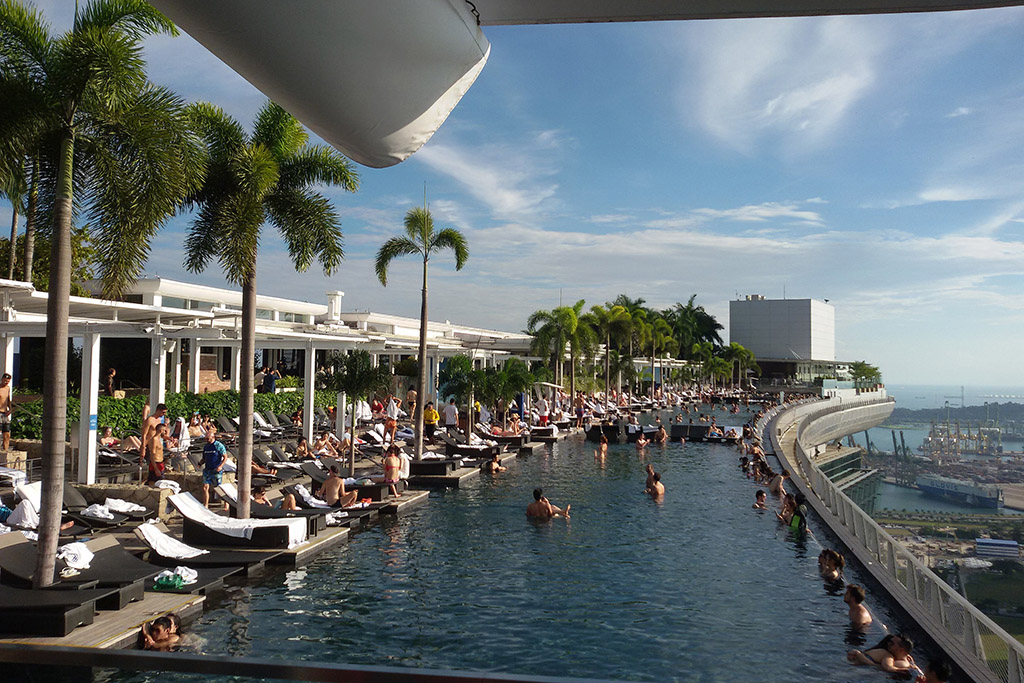

Three 55-storey hotel towers support a 340-meter-long roof garden at a height of 191 meters, the so-called SkyPark.
In total, the hotel has an incredible number of 2,561 rooms. Its most impressive and world-famous feature, however, is a 146-meter-long infinity pool.
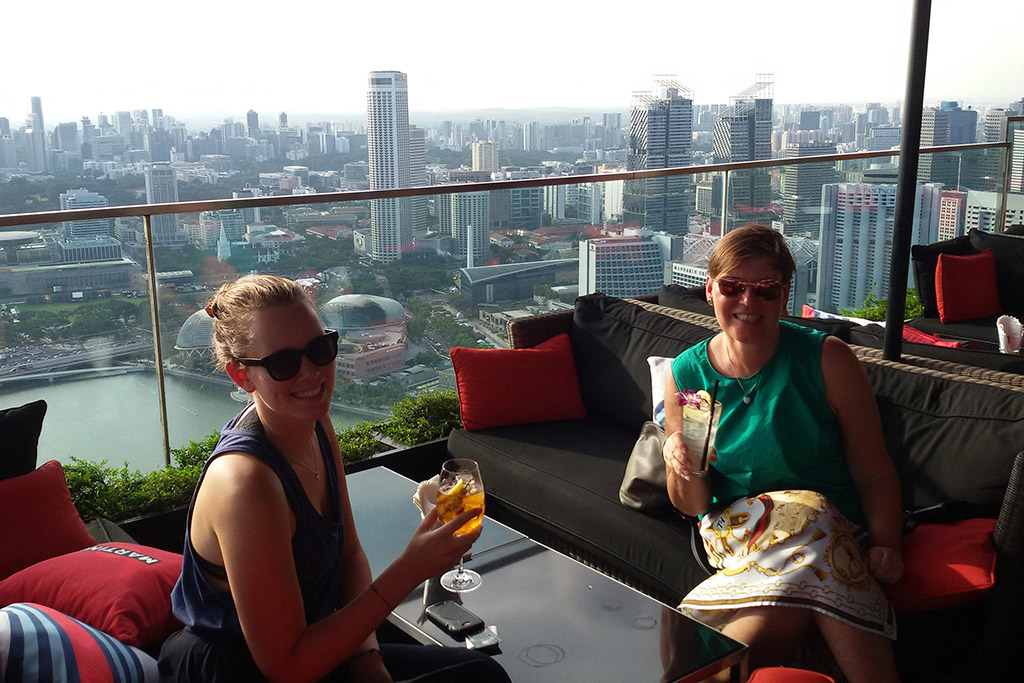

Next to the pool is a viewing platform. The roof terrace offers a 360-degree panorama of the city.
Gardens by the Bay
Gardens by the Bay is a more than 100-hectare park area that was created on man-made land in Singapore’s central district.
It is part of a governmental project to increase the residents’ quality of life through green corridors. Hence, the park landscape along the sea and at the Marina Reservoir is an attractive recreational area right in the heart of the city.
Supertrees
One of the gardens’ most picturesque features are the Supertrees. These are plant-covered steel frames with heights between 25 and 50 meters. Among other things, they are used to raise rare plants. In addition, photovoltaics are used to generate electricity for lighting and cooling systems. Also, the precipitation is collected to water the plants. Some of the trees serve as cooling towers for the systems in the greenhouses. Finally, two of the towers are connected at a lofty height with a 128-meter-long skyway.
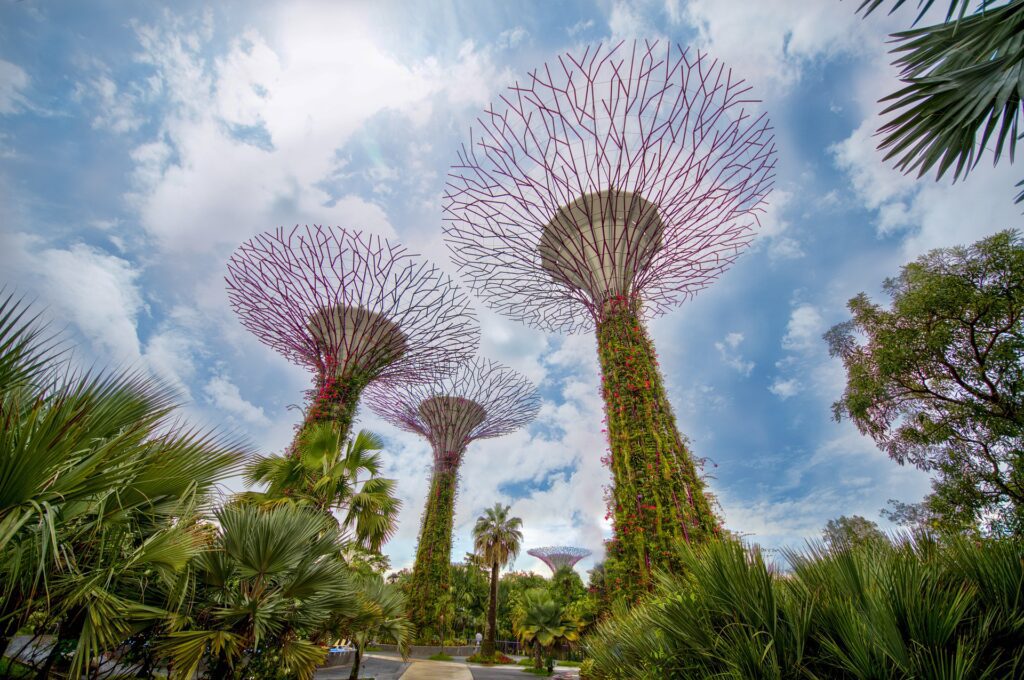

At night, the towers are illuminated and there are changing light and sound shows, so-called Garden Rhapsodies, at 7.45 p. m. and 8.45 p. m.
Flower Dome
While the visit to the Gardens is free of charge – apart from the skyway – you have to pay for visiting the Flower Dome as well as the Cloud Forest.
Covering 1.28 hectares, the Flower Dome is the larger structure. As a matter of fact, it was included in the Guinness Book of World Records as the largest glass greenhouse in the world in 2015.


Due to the mild climate, you’ll find plants from the Mediterranean as well as semi-arid climate zones. These include, for example, Chilean araucaria, olive trees, date palms from the Canary Island, African baobab trees, and many others.
Cloud forest
Even more impressive is the Cloud Forest, 0.8 hectares of a tropical vegetation zone. It simulates the climate at a height of approximately 1,000 to 3,000 meters above sea level.
A 35-meter high tower construction represents a mountain covered with typical species such as orchids, bromeliads, or flamingo flowers.
The domes are open every day from 9 a. m. to 9 p. m. The entrance fee is 20 SGD for each individual dome. Therefore, a combi-ticket for 28 SGD that entitles you to a visit to both venues is actually a great deal.
Five Best Museums of Singapore
Singapore City Gallery
As a matter of fact, there are very few places in the world that rose from simple trading ports to powerful city-states in just a couple of decades.
Obviously, the city’s rapid evolution in a very limited space was only possible due to the perspicacious planning of sustainable development strategies.
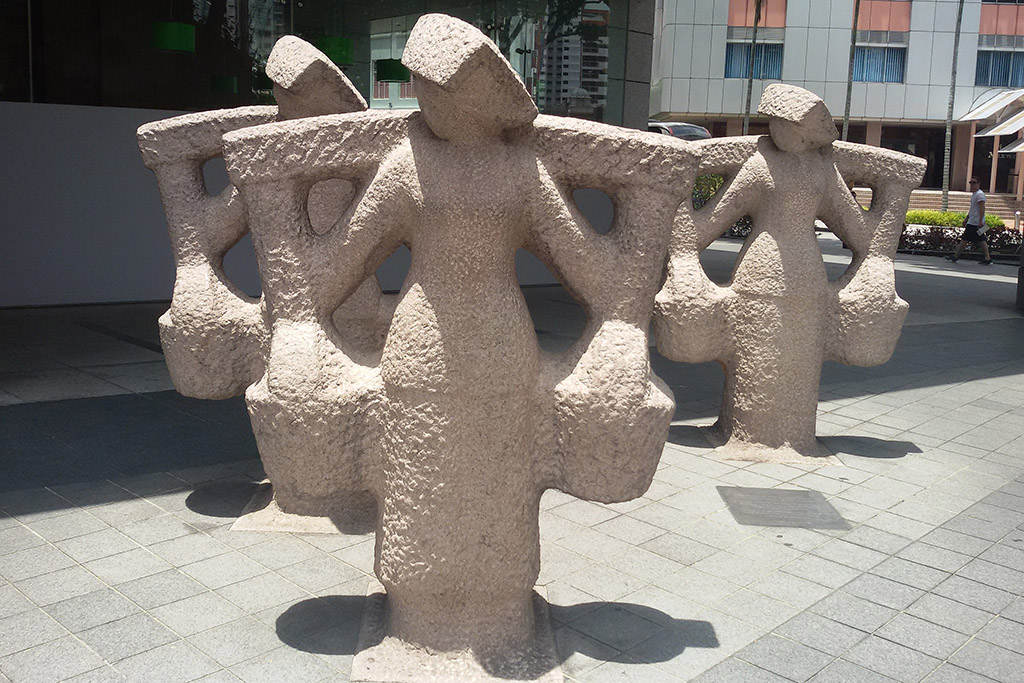

Singapore City Gallery illustrates these challenges and efforts. This exhibition with more than 50 audiovisual and interactive exhibits is divided into ten thematic sections on three floors.
Apart from a large architectural model that gives the visitors a bird’s eye view of the city center, there are also various interactive activities explaining the challenges of planning a livable and sustainable city.
Singapore City Gallery
Urban Redevelopment Authority (URA)
45 Maxwell Road
Singapore 069118
The gallery is open from 9 a. m. to 5 p. m. from Monday to Saturday and you can visit for free.
National Museum of Singapore
Wanna learn more about Singapore’s ever-changing history? Then the National Museum of Singapore is the perfect place for you.
It is the country’s oldest museum housed in a building from 1849. Not only explains the National Museum of Singapore’s history. It also exhibits handicrafts and selected precious artifacts. There is for instance the Singapore Stone, the Peranakan coffin, and John Singer Sargent’s oil portrait of the British administrator Sir Frank Swettenham from 1904.
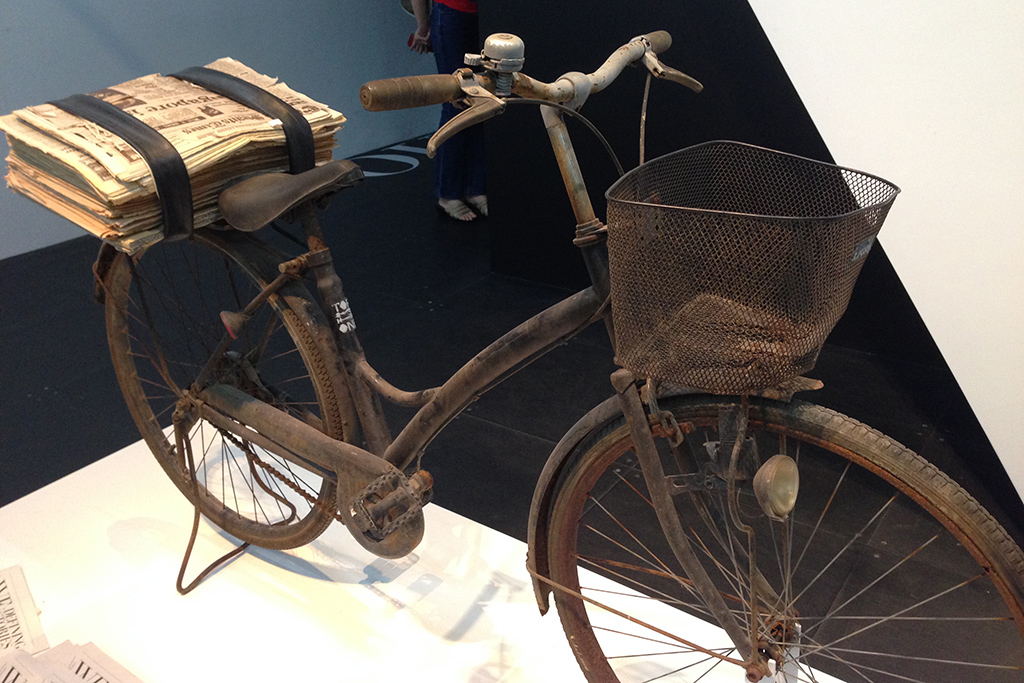

(Photo: Jacklee., Old newspaper delivery bicycle on temporary display at the National Museum of Singapore – 20140809, cropped 3:2, CC BY-SA 3.0)
The permanent exhibition is at a glass-clad annex. Obviously, it tells the history of Singapore starting with the 14th century in an alluring and gripping manner.
Initially, the museum used to house a vast collection of zoological items which later were transferred to the National University of Singapore as well as other museums in the Commonwealth.
National Museum of Singapore
93 Stamford Road
Singapore 178897
Email: nhb_nm_hospitality@nhb.gov.sg
The gallery is open every day from 10 a. m. to 7 p. m. The entrance fee for foreign visitors is 15 SGD.
National Gallery Singapore
The National Gallery Singapore shows modern art from the 19th and 20th centuries from Singapore and other Southeast Asian countries. Located in the city’s Civic District, the gallery consists of two national monuments, namely the Old Supreme Court Building and also the City Hall. Through bridges and the basement, the design of the new Gallery combines the historic with modern architecture.
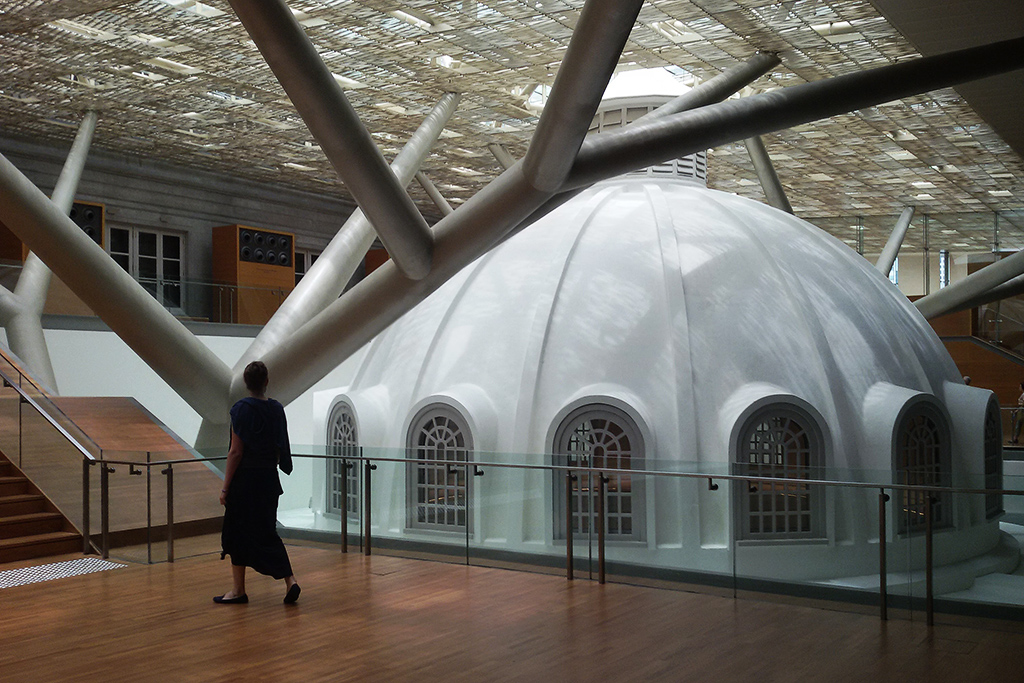

As a matter of fact, the gallery is primarily based on the National Collection of Singapore, the world’s largest public collection of modern and contemporary art from Southeast Asia.
This collection began with the legacy of 93 works donated by film mogul and art patron Dato Loke Wan Tho in 1976. Over the years, this collection has grown significantly to approximately 8,000 pieces.


The gallery is the city’s largest venue of visual arts as it aims to provide an understanding and appreciation of art and culture through a wide range of media. It focuses on the culture and heritage of Singapore, but also its relationship to other cultures from Southeast Asia, Asia, and the rest of the world.
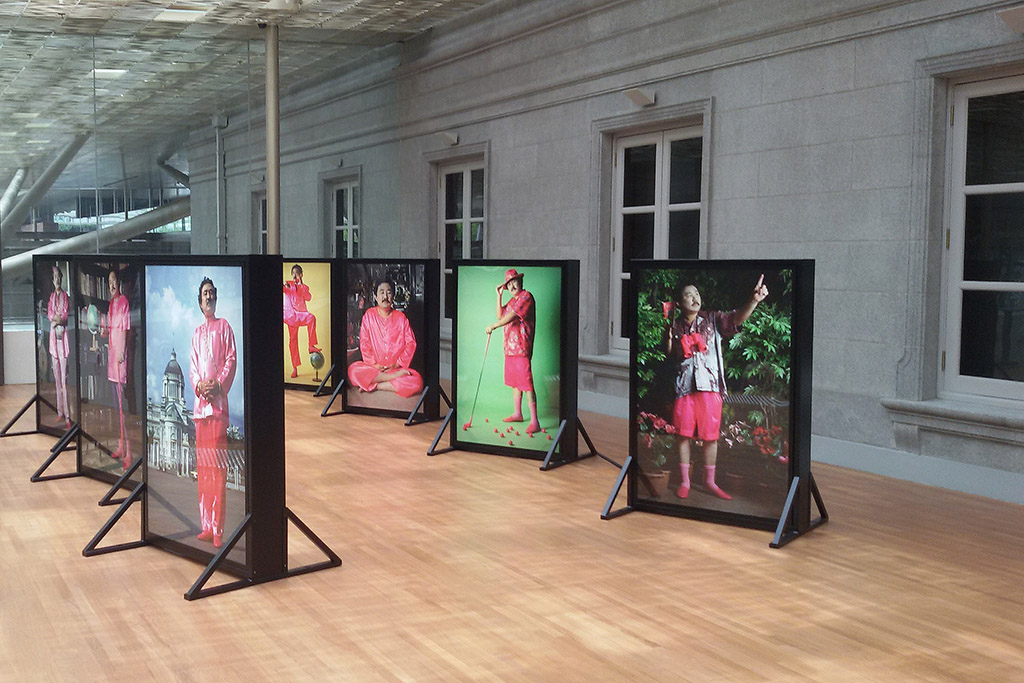

National Gallery Singapore
1 St Andrew’s Road
Singapore 178957
Email: nhb_nm_hospitality@nhb.gov.sg
The gallery is open every day from 10 a. m. to 7 p. m. The entrance fee for foreign visitors is 20 SGD.
ArtScience Museum
I’ve pointed out the unique building that houses the ArtScience Museum already during the walk through the Bay Area above.
This museum was inaugurated by the Prime Minister of Singapore in 2011. It is actually the world’s first museum of its kind, hence, presenting important exhibitions that combine art, science, culture, and technology.
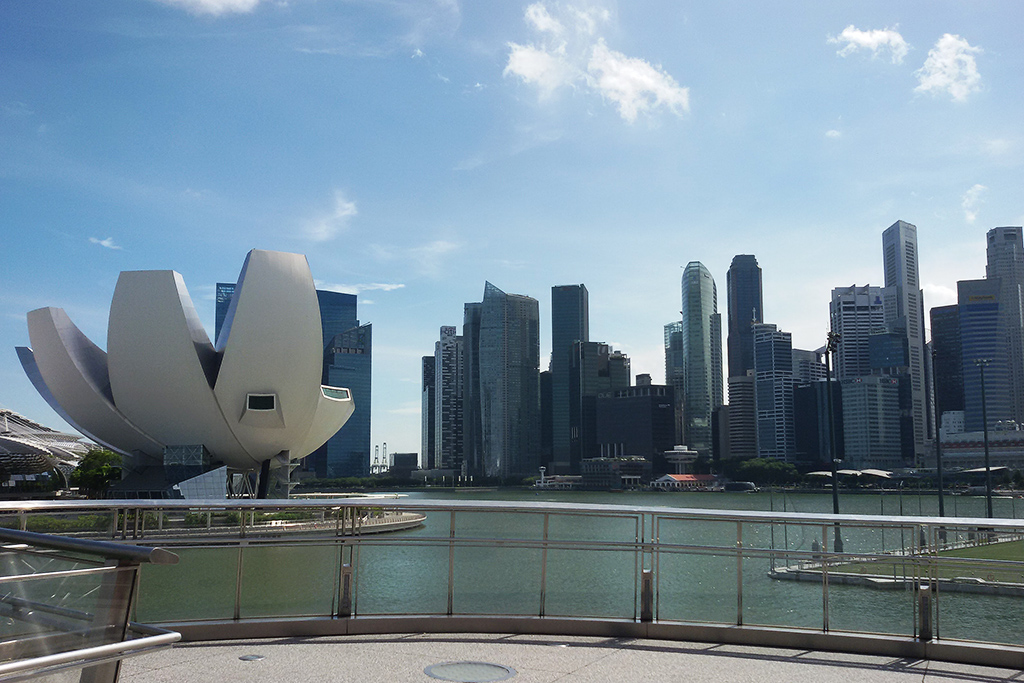

The ArtScience Museum has 21 galleries in a total space of 6,000 square meters. Although a permanent exhibition at the ArtScience Gallery has been intended, so far, the museum has hosted mainly changing exhibitions curated by other museums.
ArtScience Museum
6 Bayfront Avenue
Singapore 018974
Email: museumenquiries@marinabaysands.com
The gallery is open every day from 10 a. m. to 7 p. m., however, on Friday and Saturday till 9 p. m.
Since there are various exhibitions taking place at the same time, you can either buy a single ticket for 18 SGD or one that grants access to three shows of your choice for 35 SGD.
Asian Civilisations Museum
The Asian Civilizations Museum is part of a network of four museums in Singapore. The other three are the Peranakan Museum, the National Museum of Singapore, and the Singapore Art Museum.
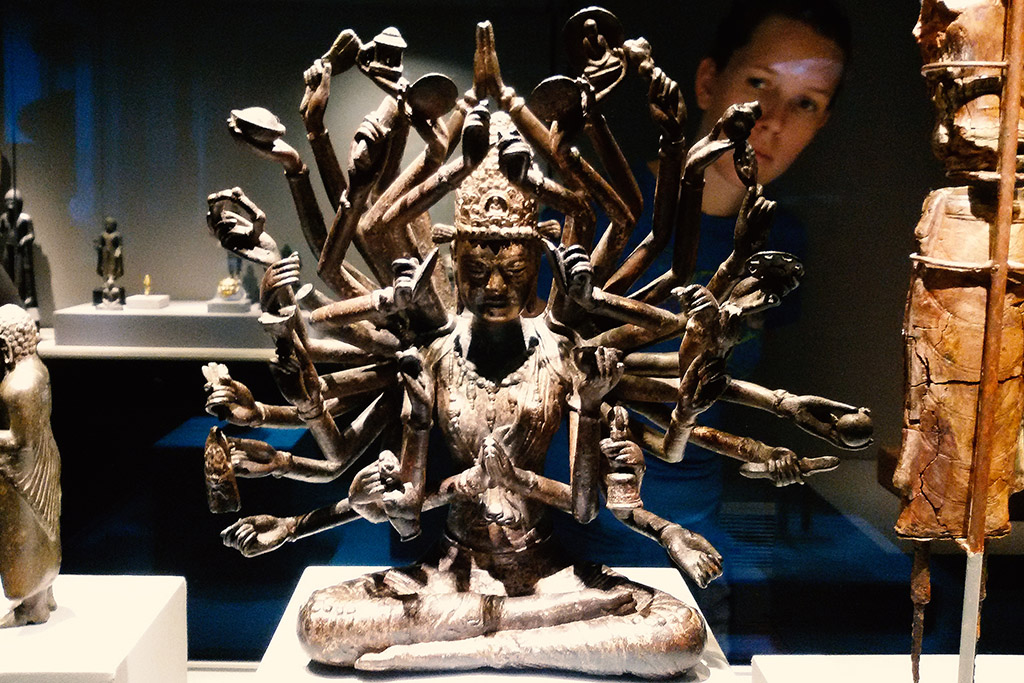

Fantastic ancient art….
It is one of the most important museums in the region, specializing in Asian cultures and civilizations. Hence, the museum specializes in the history and cultures of China, Southeast Asia, South Asia, and West Asia. Obviously, these are basically the countries from which the various ethnic groups in the city descended.
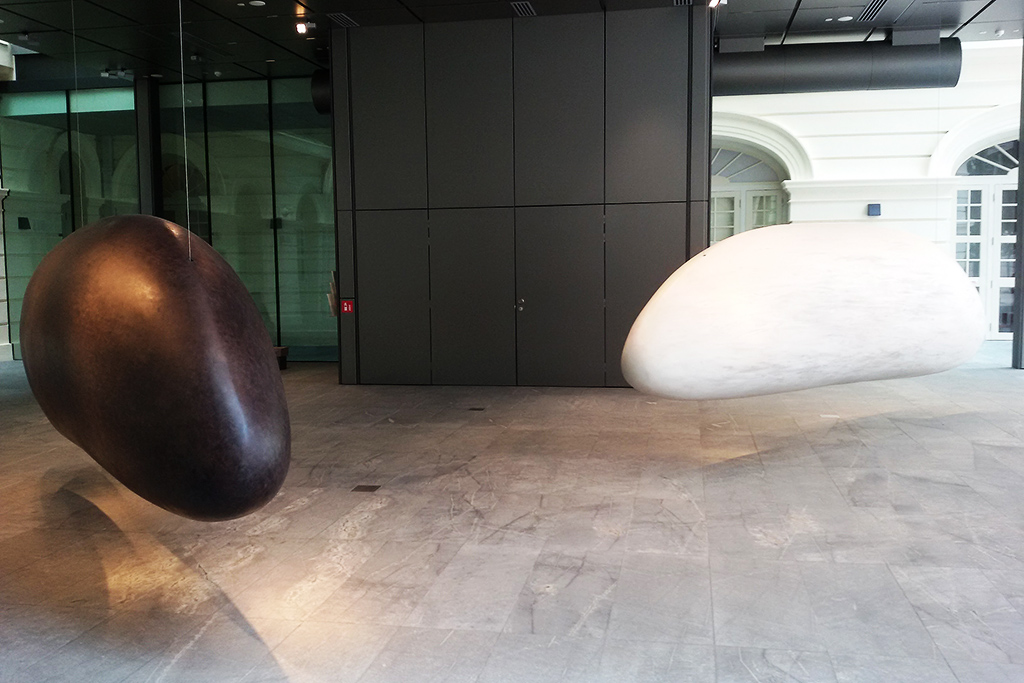

The Grains of Thoughts by Eng Tow.
Yet, most of the exhibits focus on Chinese civilization. Therefore, a highlight of the exhibition is the cargo from a sunken Chinese merchant ship from the 9th century. The ship was sailing towards today’s Iran and Iraq and was discovered in the Java Sea in 1998. The salvaged cargo included more than 60,000 ceramic items made in China during the Tang Dynasty. Also, there are coins and objects made of precious metals.
Asian Civilisations Museum
1 Empress Place
Singapore 179555
Phone: +65 – 63 32 77 98
Email: nhb_acm_vs@nhb.gov.sg
The gallery is open every day from 10 a. m. to 7 p. m., however, on Friday till 9 p. m. The entrance fee for foreign visitors is 20 SGD.
Three Best X-tra Tours
Sentosa
The island was initially used as a British military base, but today, it is a recreational area for the people of Singapore as well as their visitors. Whereby I find that there is so much authentic culture to experience – I really don’t need further man-made amusement options.
However, Sentosa offers a number of entertaining attractions such as museums, shows, casinos, and nature experiences.
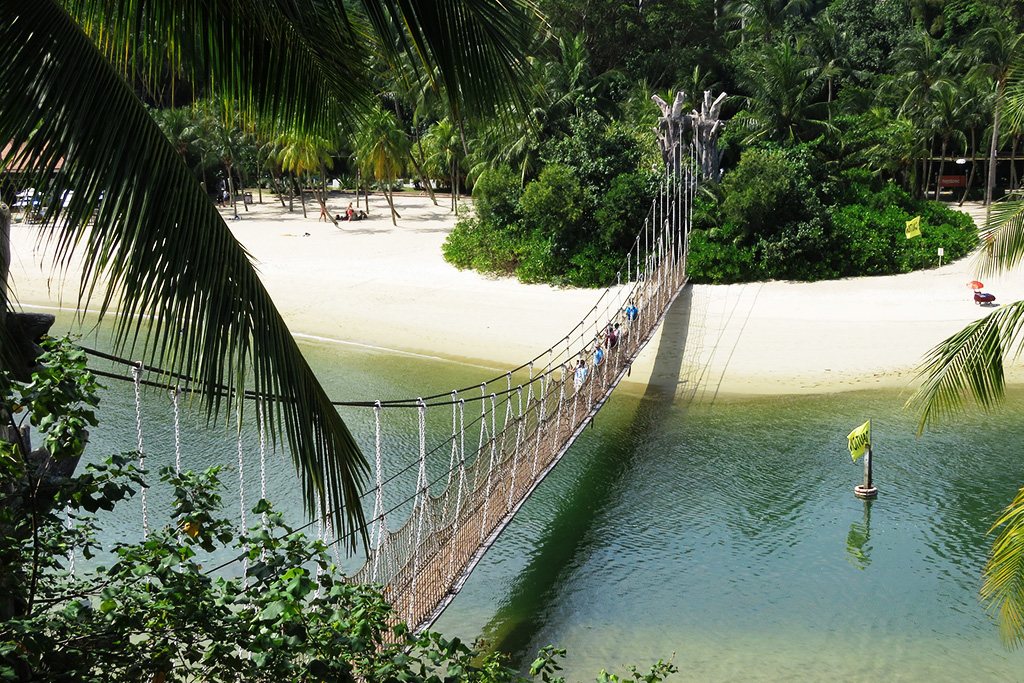

Through land reclamation, Sentosa has grown to five square kilometers. It is the most popular destination for weekend outings, particularly with families. Worth the visit are among others an aquarium, an orchard garden, a butterfly park, and the vulcanoland theme park.
On Sentosa’s southern end are three artificial beaches filled up with sand imported from Indonesia and Malaysia. Numerous restaurants and bars on all three beaches provide good dining.
In the following section, I’m recommending a hike from Mount Faber all the way to Kent Ridge Park. However, you can enjoy the views from Mount Faber even without breaking a sweat. A cable car has connected the summit with Sentosa since 1974. It operates daily between 8.30 a. m. and 11 p. m.
Southern Ridges
Mount Faber Park
Mount Faber is a hill about 94 meters high. The summit is accessible over two roads. Yet, there are also many footpaths leading up the hill. We went by MRT to the HarbourFront stop. From there, we hiked for maybe half an hour up the Marang Trail. Make sure to exit the station through door D.
The vegetation around Mount Faber is a small secondary rainforest. It is a great destination as it grants panoramic views of Singapore’s central business district and the hike uphill is really not very hard. Also, on its slope is also the cable car stop I’ve mentioned above in the Sentosa section.
Henderson Waves
Hiking from Mount Faber westwards, you’ll get to the iconic Henderson Waves.
These waves are actually a bridge over a freeway. 36 meters above the road, the waves are the highest pedestrian bridge in Singapore.
True to its name, at 274 meters, the bridge is twisting and turning in the shape of a wave. This design forms niches where hikers can rest’n’relax and enjoy the lush surroundings.
Especially at dusk, walkers linger a bit to admire the illuminated bridge. From 7 p. m. to 2 a. m., LEDs are creating stunning effects.
Telok Blangah Hill Park
As you keep walking, you’ll get to the adjacent Telok Blangah Hill Park. This park has been a meeting place for the merchant community since the early 19th century. To this date, the Alkaff Mansion, a colonial bungalow built by an Arab merchant, is proof of the merchants’ wealth.


There are two trails through Telok Blangah Hill Park. One is a common trail, the other one is an elevated walkway.


The latter is actually a metal bridge that offers you the experience of hiking through the secondary forest of Telok Blangah Hill at eye level.
Kent Ridge Park
Finally, we reached Kent Ridge Park – and first of all, we took a break from all that hiking. Then, we checked out what this 47-hectare public park has to offer.
The park was officially inaugurated in 1954 and declared by the National Security Council as one of the city’s 11 sites of WWII. After all, it was the ground of the battle of Bukit Chandu, one of the last and most ferocious battles against the Japanese troops in 1942. Therefore, the last colonial bungalow on the premises was restored and transformed into a war museum.
Bukit Chandu War Memorial
31 – K Pepys Road
Singapore 118458
The gallery is open from Tuesday to Sunday from 9 a. m. to 5.30 p. m. The entrance fee is only 2 SGD.
In the park are many different walking trails and cycling routes. Panels provide educational information on the flora and fauna.
It’s a truly nice place. We only were a bit exhausted from all the hiking in Singapore’s hot’n’humid climate to really enjoy it. Hence, a valid alternative would be going to the Pasir Panjang MRT station which is about ten minutes from Kent Ridge Park.
Wildlife Reserves Singapore
The Night Safari is one of Singapore’s must-do activities. While you can obviously obtain a single ticket for this outstanding attraction, it seems to be a good idea to get a combi ticket for four parks which in comparison is much cheaper.


However, if you don’t have too much time to spend in Singapore, this can be a bit tricky. The parks are beautiful, but not in the city center. Will say, you have to spare at least half-day per park. Although we managed to combine a visit to the zoo with the Night Safari and even skipped the bird park, I find that we finally sacrificed too much time. If I did it again, I would visit either exclusively the Night Safari or just combine it with a same-day visit to the zoo.
Yet, if you are a huge animal lover or travelling with kids, the combi pass might be perfect for you.
River Safari
The River Safari has been the last addition to the Wildlife Reserves Singapore consisting also of the zoo, the Night Safari, and the Jurong Bird Park. Obviously, it is a river-themed wildlife park.
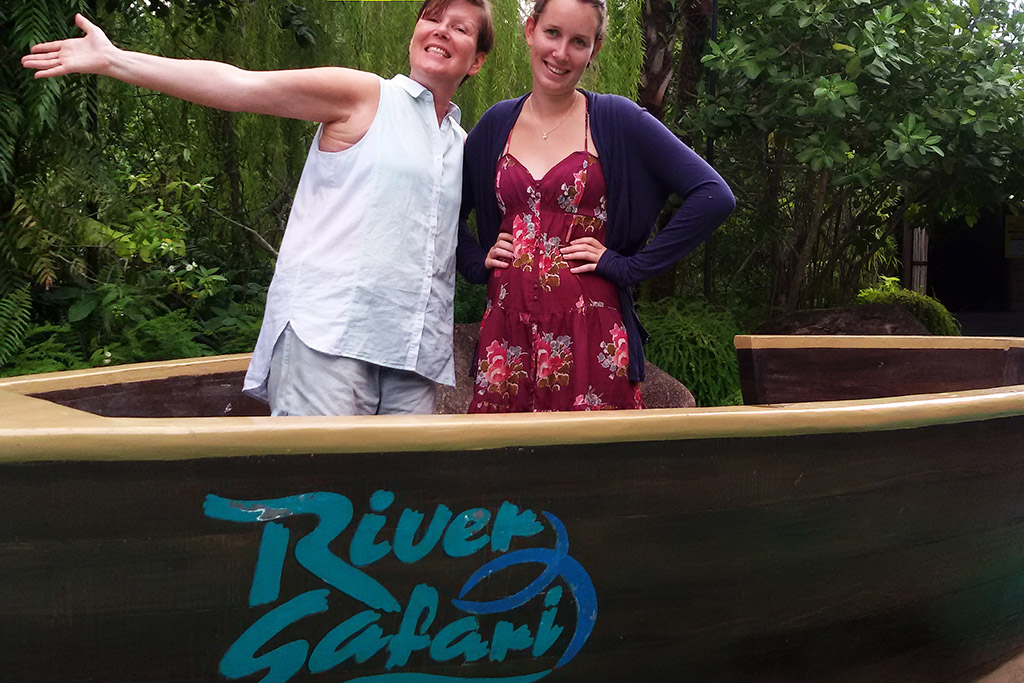

As I read that the park is home to 400 plant species and over 7,500 aquatic and terrestrial animals, I imagined….actually, I don’t even know what I expected. Whatever it was, it was more than the park has to offer. Will say, I was not impressed.
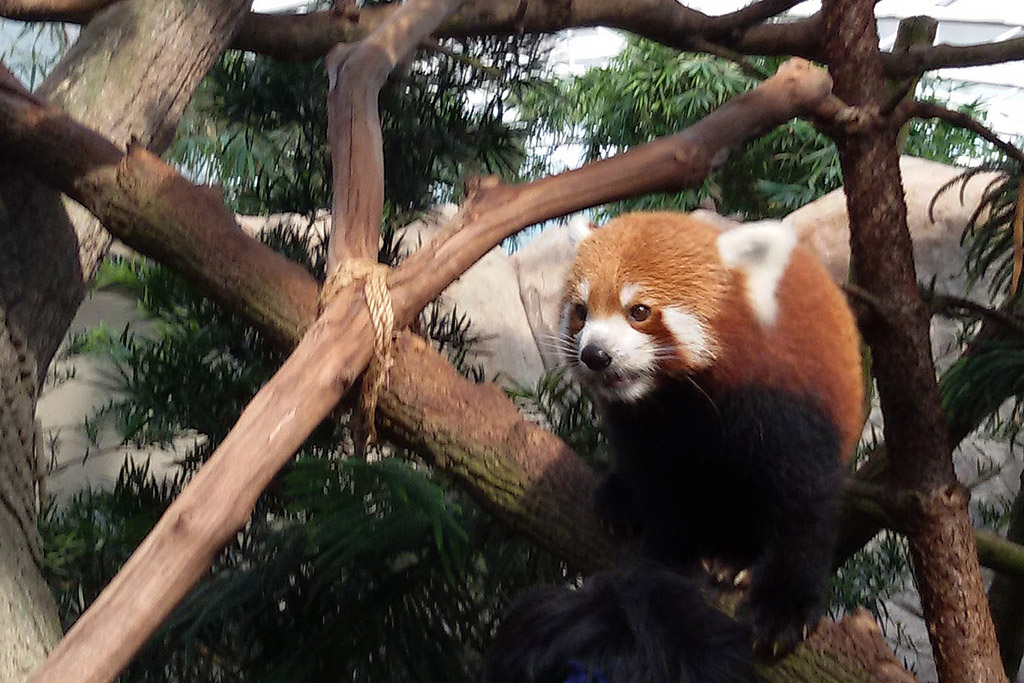

No, he doesn’t live in the water, yet by the waters. Mind you, he belongs in this zoo, too.
River Safari Singapore
80 Mandai Lake Road
Singapore 729826
The park is open every day from 10 a. m. to 7 p. m. The entrance fee is 36 SGD for foreign visitors. However, various combi-tickets are starting at 50 SGD for two parks and 80,75 SGD for a 4-Park-Ticket.
Singapore Zoo
The Singapore Zoo was opened in 1973. It is operated by the institution Singapore Wildlife Reserves, which also manages the River Safari, the Night Safari, and the Jurong Bird Park.


I don’t feel comfortable seeing animals being used as props.
There are about 315 species of animals in the zoo which is a spacious and nicely arranged tropical park.
Singapore Zoo
80 Mandai Lake Road
Singapore 729826
The park is open every day from 8.30 a. m. to 6 p. m. The entrance fee is 39 SGD for foreign visitors. However, when buying your ticket online, you get a discount. Also, various combi-tickets are starting at 50 SGD for two parks and 80,75 SGD for a 4-Park-Ticket.
Night Safari
Since the zoos are pretty far from the center, we combined the visit to the zoo with the night safari since both attractions are door-to-door. Hence, after we visited the zoo in the afternoon, we had to wait for a bit at the safari’s gates.
Instead of reversing the day-night cycle of animals as other zoos do, the Night Safari is set in an open humid tropical forest. It is divided into seven geographical zones, which can be explored by walking and from a mini-train.
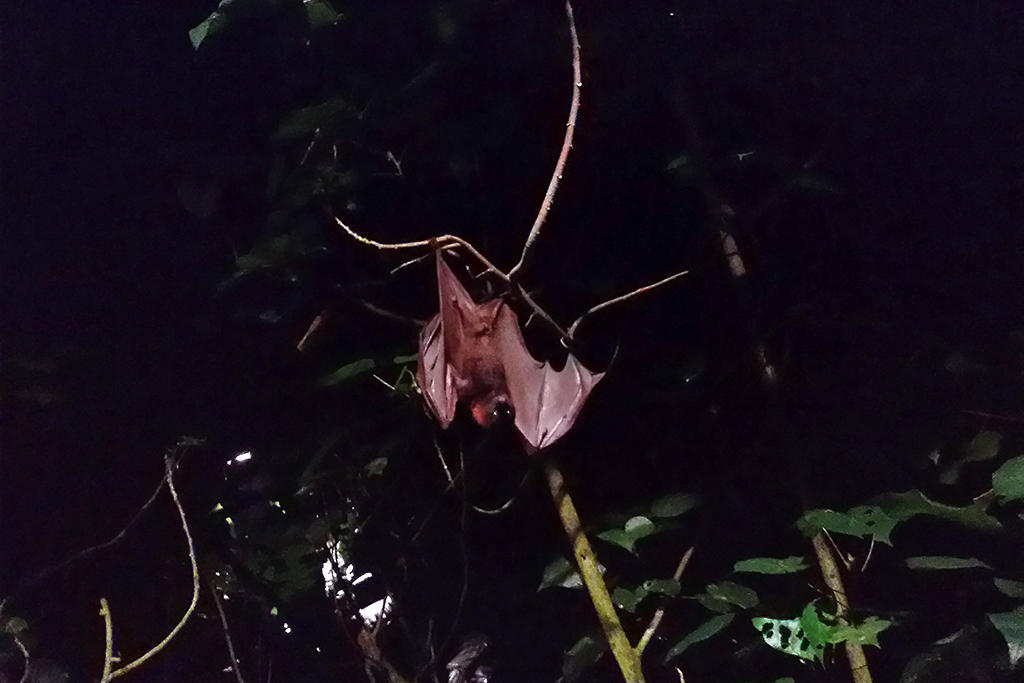

After we got in, we first visited the Creatures of the Night Show. At this show, a conferencier and some zookeepers explain and demonstrate in a highly entertaining way some fascinating facts about the creatures of the night you’re about to see.
Eventually, we hopped on the mini-train which is the most popular way of visiting the night zoo on a 40-minute drive. It takes you through the six geographical zones where different habitats are replicated.
Night Walk
Once you’re done, you have enough time to explore the nocturne terrain on walking trails. These paths are thematically assigned and you get to see wildlife you cannot spot from the mini-train.
The so-called leopard trail is the longest and probably most exciting walking trail. The leopards are handled according to the European Endangered Species Programme. They have been successfully bred and then forwarded to zoos in different countries for breeding programs.
Night Safari
80 Mandai Lake Road
Singapore 729826
The park is open from Thursday to Sunday from 6.30 p. m. to 12 a. m. The entrance fee is 51 SGD for foreign visitors. However, when buying your ticket online, you get a discount. Also, there are various combi-tickets at 71,25 SGD for two parks and 80,75 SGD for a 4-Park-Ticket.
As I said above, if you opt for the 4-Park-Ticket, apart from the three zoos, also the Jurong Bird Park is included. At this bird park, 600 species are living in huge aviaries and I’m sure it’s a great place. However, after visiting the three zoos, we had enough wildlife and enjoyed the urban sides of the powerful city-state that is Singapore.
Map
Here is a map that will help you find all those mesmerizing places I’m introducing above:
Practical Information
How to Get There
Air Travel
Singapore’s Changi Airport is a world-famous and one of the most important airports in Southeast Asia. It consists of four terminals which are connected by a monorail.


An MRT subway stop is located between Terminals 2 and 3. From there, you can get to the city center quickly and cheaply.
A city shuttle that leaves the airport every 15 minutes and takes you to most hotels in the downtown area costs 9 SGD.
Nevertheless, you can also take a cab. You can book them at taxi stands in the arrival areas of Terminal 1 and 3. The ride to the city center will set you back between 20 and 40 SGD and takes about 30 minutes.
Some major hotels offer a free shuttle. But make sure that the shuttle is not complimentary. Otherwise, you might pay much more for the transport that they send than if you arrange your transport yourself.
This being said, it’s wiser to overpay for a safe trip than risk your well-being on arrival. You’ll find more on this important topic in my post Keep Calm and Travel Solo.
Howsoever, for your comfort and your safety, here you can pre-book a reliable and reasonably priced airport shuttle.
Land Travel
If you already are on the Asian continent, you can travel to Singapore by train or by long-distance bus, obviously.
There is a single-track railway connection to Malaysia. Still, since 2018, there is no direct connection between Kuala Lumpur and Singapore. This way, the once most comfortable option became one of the most complex ones.
So most international visitors are taking the bus. Coaches are going all the way north to Penang, however, after our last trip, I’d really refrain from this option and rather hop on a plane to George Town.
Various companies are going between Kuala Lumpur and Singapore. Fares vary from 20 to 30 SGD – and after my experience, I would rather pay a bit more and deal with more civil tellers and drivers. Also, note that different companies operate from different stations in Singapore. Especially in the early morning, this might be a valid reason for preferring certain carriers.
No matter what, in any case, you have to go through customs at the border crossing around Woodlands in northern Singapore.
Tips for Crossing the Border Between Singapore and Malaysia
Crossing the border from Singapore to Malaysia is usually pretty quick and uncomplicated. However, during rush hour, it can take more time.
First, you exit the bus to officially leave Singapore. Normally, you have to bring your carry-on bag and personal items with you and sometimes also your large luggage. Don’t you worry, the driver will inform you accordingly in a very determined way.
At the immigration area, take off hats and sunshades. To make the process smoother, have all of your documents filled out. Ideally, open your passport on the page with your personal data and photo. Also, do not use your phone in the immigration area at any time. Be very cooperative and courteous to the agents.
Once everyone is done, you get back on the bus to cross the Causeway Bridge. Now you are at the Malaysian customs. Again, you have to bring your large luggage with you to be screened.
Normally, the bus is waiting for the passengers. My funny story that you can enjoy above is not the standard, so don’t let it scare you!
How to Get Around
Singapore has a comprehensive and relatively inexpensive public transport system. Apart from the MRT subway, there is a well-developed bus system. Since the buses only stop upon request, passengers must signal the bus driver to stop by waving their hands.
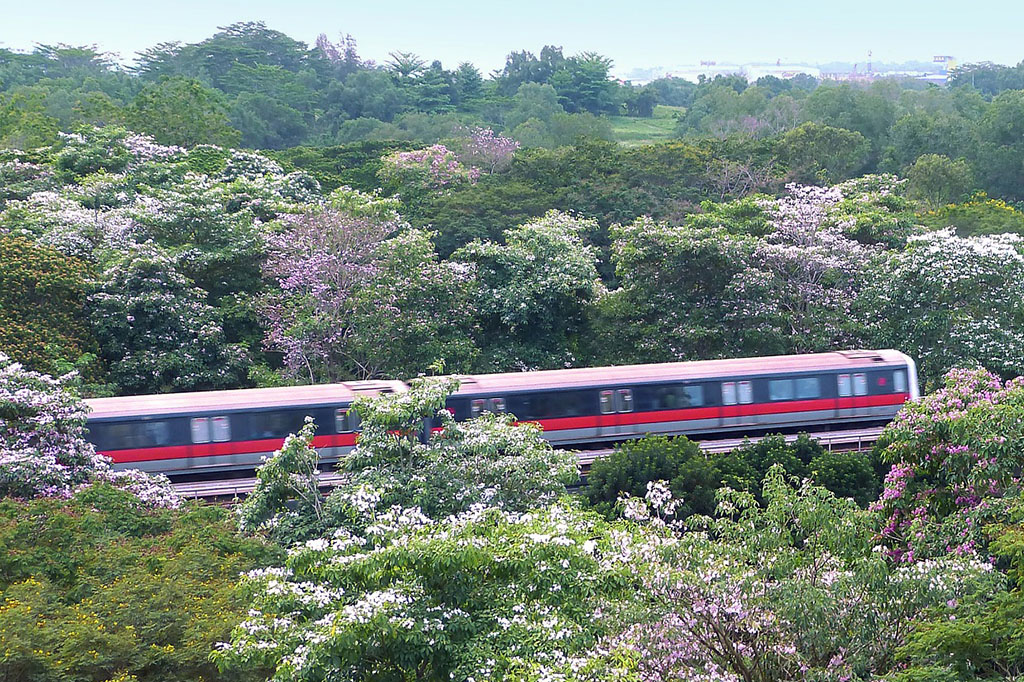

Cabs in Singapore are common and relatively cheap. However, there are severe bottlenecks during rush hour so taking the MRT can be your better bet.
I highly recommend the Singapore Tourist Pass that you can get for one, two, or three days. It grants unlimited rides on all public transport for only 10, 16 respectively 20 SGD. You also have to pay an additional 10 SGD for the card that you’ll get back as you return the card.
What to See
I’m an avid solo-travelling woman. Since solo-travel doesn’t equal solitude, I love to join organized tours here and there. Also, to make sure that Singapore’s attractions you intend to visit aren’t sold out you might want to book ahead. However, here are some ideas of what to do and how to visit Singapore in a safe and easy way*:
Where to Stay
As much as I love Singapore, finding adequate accommodation within my budget is difficult. Far more difficult than for instance in Tokyo or other cities in Japan, by the way. However, I must admit that I’m pretty cheap when it comes to lodging – you can read about some of my quirkiest stays in this post.
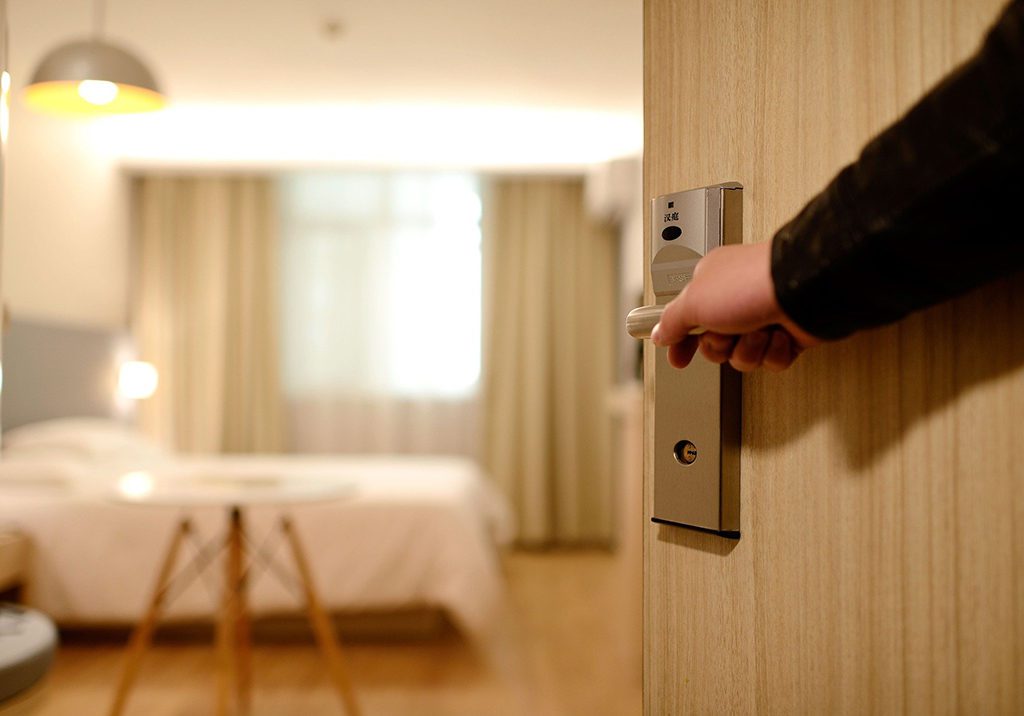

This being said, I can recommend staying at the Rucksack Inn*. It’s a lovely place for those who are on a really tight budget. Since the branch on Hongkong Street is closed, you can check in at Rucksack Inn @ Lavender Street*.
A valid option for those who are looking for a simple yet comfortable room at a reasonable price that is not too far from most of the points of interest might be the Aqueen Lavender*.
If you can afford to splurge, spending the night at the Marina Bay Sands* is, obviously, a once-in-a-lifetime experience. To take it down a notch and still enjoy a prime location, you might want to opt for the Robertson Quay Hotel*
If neither of those places is for you or if you simply want to check out other lodging options, you can do so on this map*:
Booking.comWhat to Eat
Singapore’s cuisine is obviously characterized by the cultural influences of its ethnic groups. Their mutual influences are omnipresent in the city. In addition to traditional recipes, there are always new fusions and variations.
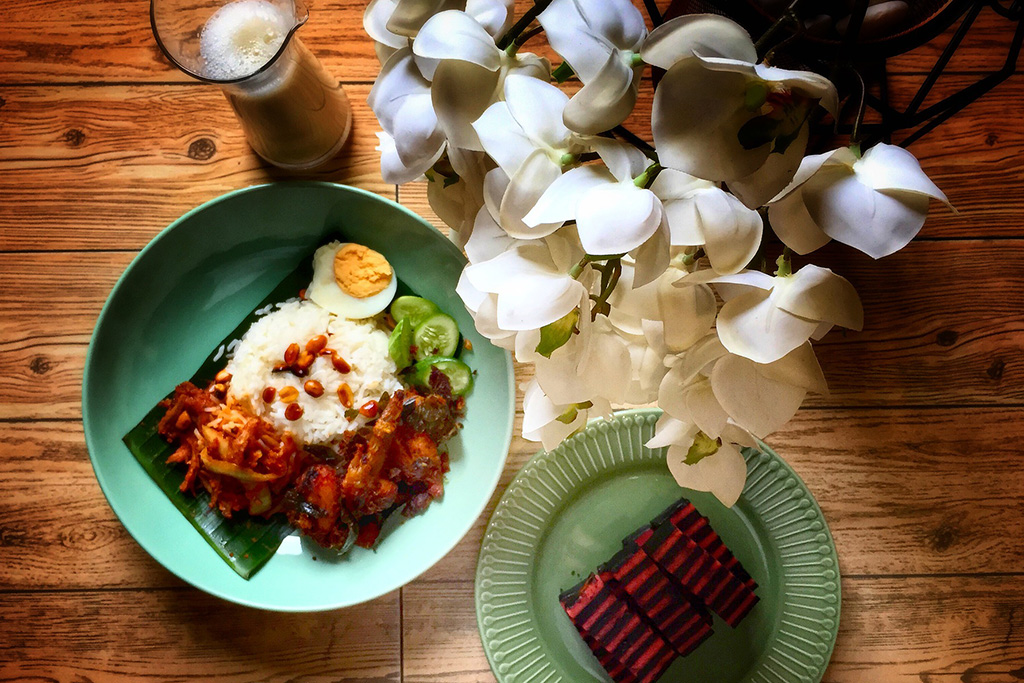

This shows in dishes such as Laksa, Yong Tau Foo, or Roti Prata. Over the years, they have become part of the extensive range of national dishes.
Great dining places are the many food courts that cater to workers and employees. Great eateries are around Chinatown. If you are looking for excellent Indian dining, check out the restaurants on Race Course Road. My favorite is The Banana Leaf Apolo, but the others are worth the try, too.
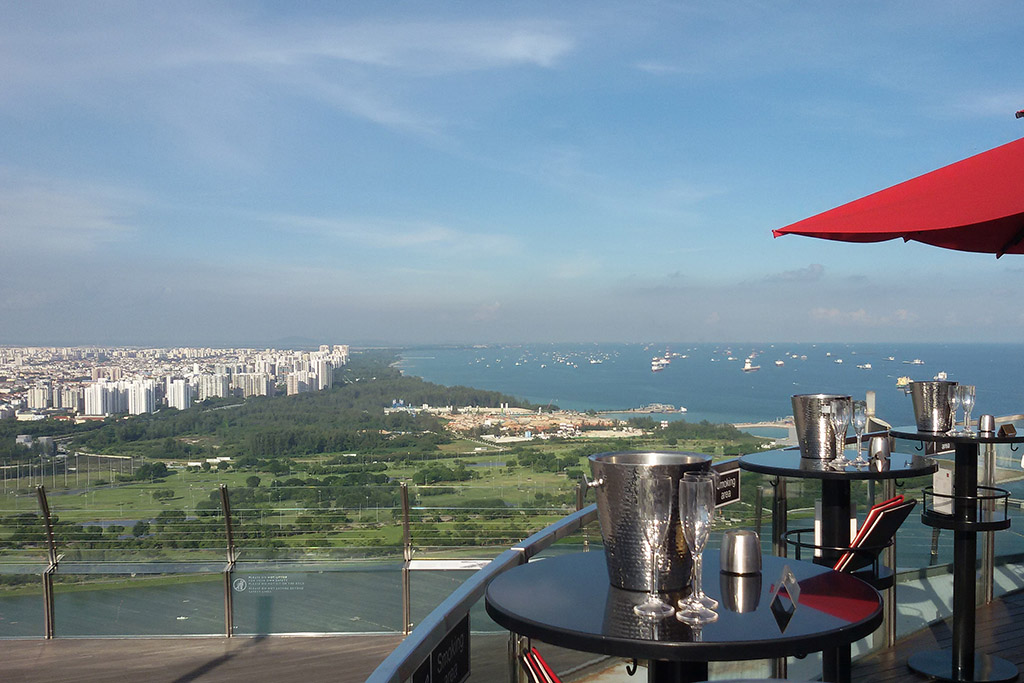

To experience some fine dining at the iconic Marina Bay Sands*, you don’t need to go to one of their restaurants or break the bank. The small but satisfying menu at the CÉ LA VI Club Lounge with a choice of burgers, pizzas, and other snacks might just do the trick at a reasonable price.
Cash And Cards
In Singapore, you pay with the Singapore Dollar. The current series of bills was introduced in 1999 and is available in 2, 5, 10, 50, 100, 1,000, and 10,000 SGD. Also, there are coins of 1, 5, 10, 20, and 50 cents as well as 1 dollar.


One US dollar equals 1.36 Singapore Dollars (SGD) as of August 2023, but you can check the current rate on this page.
Language
Singapore’s official languages are Chinese, English, Malay, and Tamil. Obviously, English is the main business language and the lingua franca. It is also the language of instruction in a large number of schools.
Communication and Connection
Like during most of my trips where European roaming was not available, I did not get a national SIM card. I rather used free WiFi. There was a connection to the internet without any issue at basically every eatery or café and, of course, hotel. Worked like a charm.
However, if you insist on being online 24/7, you can get a national SIM card. I’d recommend StarHub since they have a card, especially for us travellers. Starting at 12 SGD, you can even use their bundled roaming data across other popular destinations like Malaysia, Indonesia, Thailand, and more. Also, you can preorder your card from home and collect it at Changi Airport on arrival.
In Singapore, plug type G is the official standard – it’s the one they use for instance also in the United Kingdom.
The standard voltage is 230 V and the frequency is 50 Hz.
But as you know, nowadays, all these chargers for phones and readers and computers have integrated adapters so that different voltages and frequencies don’t really matter.
Therefore, gone are the days when you blew your electric appliances since you forgot to switch them from 110 to 220…good times.
By the way, you’ll find this kind of practical travel info in my post World’s Most Complete Travel Information – as a matter of fact, an indispensable globetrotter-classic.
Recommended Reads
There are two excellent books dealing with the history of Malaysia respectively Singapore.
While The Singapore Grip by J.G. Farrell focuses rather on the life of the British colonialists and the country’s development before WWII, the very complete oeuvre The Long Day Wanes: A Malayan Trilogy by Anthony Burgess deals in a fascinating and gripping style with ethnic and also sociological development and issues.
Both are fascinating and educational reads.
Pinnable Pictures
If you choose to pin this post for later, please use one of these pictures:
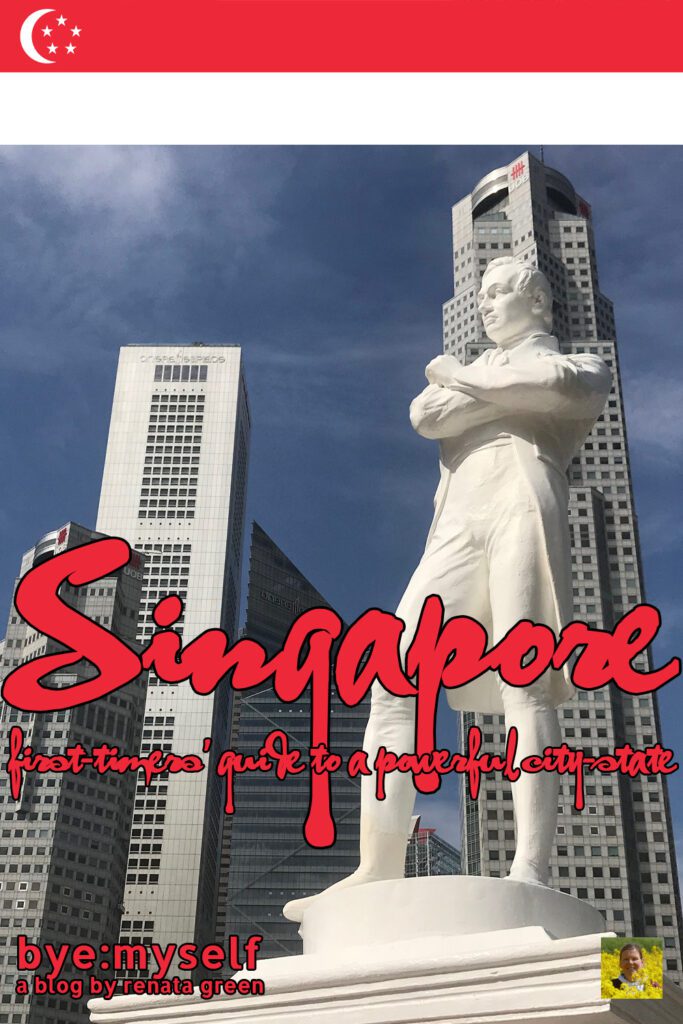



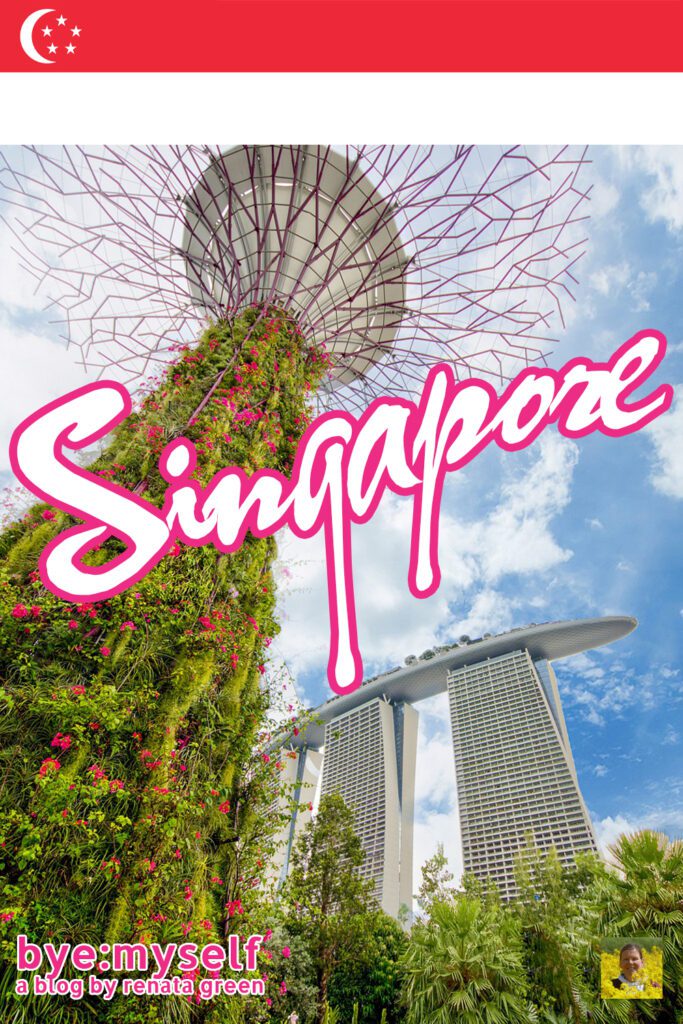



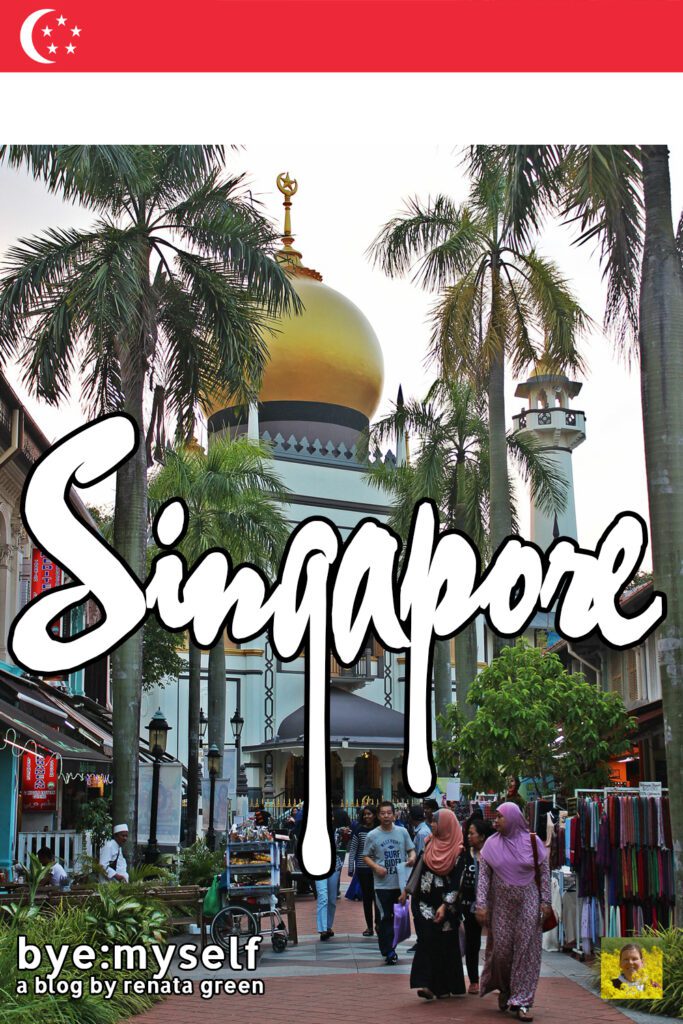

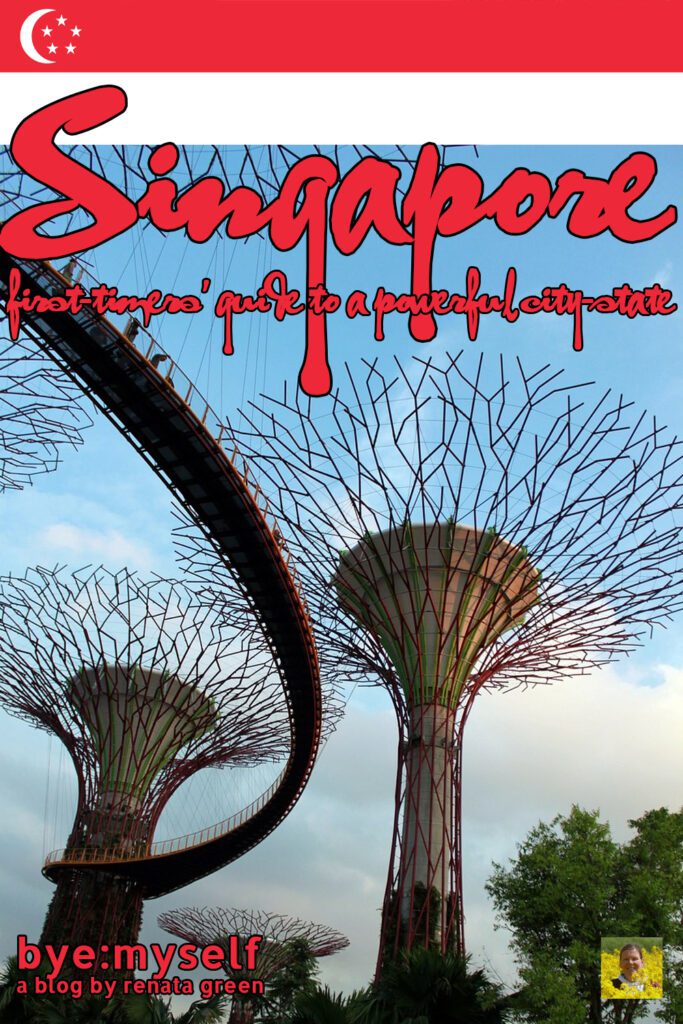

Note: I regularly complete, edit, and update this post – last in August 2023.
Did You Enjoy This Post? Then You Might Like Also These:
KRABI and AO NANG – the Gateway to Paradise
KAMPHAENG PHET and PHITSANULOK – two (un)necessary detours
Island Hopping in the Andaman Sea – Koh Phi Phi, Koh Lanta, Koh Jum
SUKHOTHAI – 200 temples at your choice
24 hours in BANGKOK
THAILAND – all the must-see places
CHIANG MAI – Ten out of 200 Temples
From the Sunken Kingdom of AYUTTHAYA to the Monkey Temple of LOPBURI
* This is an affiliate link. If you book through this page, not only do you get the best deal, I also get a small commission. That helps me run this blog. Thank you so much for your support!

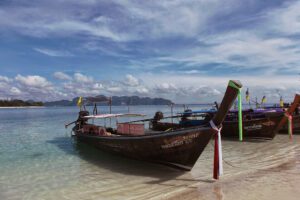
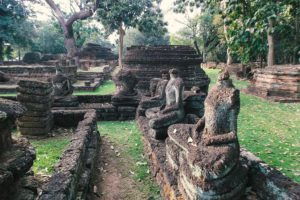
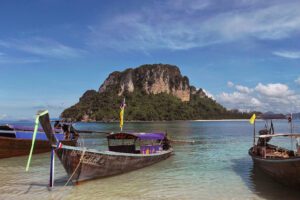
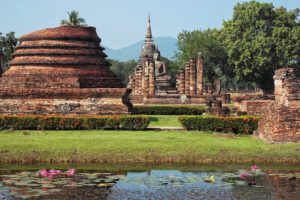
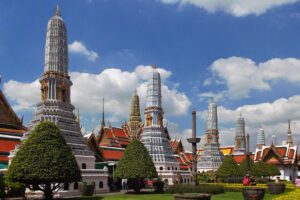
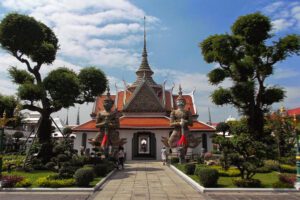
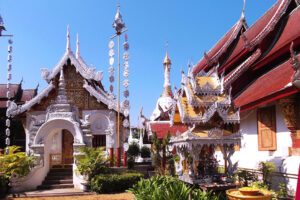
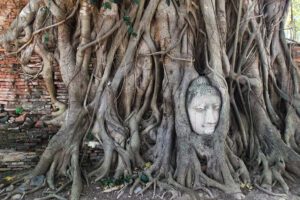
Hello, this is a great post on Singapore! Thank you for this elaborated guide, it will be very helpful when I’m going to Singapore next fall.
You’re very welcome – glad I can help 😉
There is just too much to see and do in Singapore and this is why it is one of my favorite destinations. We love the night safari. It was a unique experience for the kids. We also skipped the bird park since we no longer have time.
I am sucker for museums and learning about places. I really enjoyed learning about singapore!
Singapore is a great place – one of my favorite cities in the world!
This is such a comprehensive guide to Singapore. The portion on the King and I had me laughing. Great writing!!
Glad you enjoyed it 😀
I was often in Singapore since it was our Regional HQ when I was still work I ng full time. But it is the Bayfront I would like to see…with all the changes from 30 years ago!
Oh, I so envy you – if I could, I would visit much more often 🙂
Although spending part of my school life in Asia (Japan), I never really knew too much about Singapore until I went there with my fiance, who spent 10 years there with his expat parents. While I am not a big fan of cities generally, Singapore is definitely in a class of its own. Having spent a while exploring there, I am in awe of their determination and foresight in building wonderful nature-inspired spaces for people within the limited area on the main island. For someone like me who loves being among nature, Singapore had a lot to offer. You have put together a fabulous informative guide here for anyone seeking to visit and explore this wonderful small, yet incredible country.
As a matter of fact, I found Japan even more controlling and kind of restricted than Singapore 😉
I’ve never spent more than a week or less in Singapore and now I can see that as a result I’ve missed out on a lot!! Singapore is in many ways, over the top and the photo of the gondolas in the Marina Bay Sands is a lovely reminder of that. I will definitely tick some of these off my list on the next layover or stop here!
I liked your writing style, it is totally reader-friendly. The way you described the king of the road, left me in splits. I can very well relate to that experience of yours. It is nice to see that your humor was intact even in a tough situation. This article is a nice comprehensive guide around the city, though Singapore was never on my list, after reading your article I definitely want to visit it.
Thank you, I’m very glad you appreciate it 🙂 As a matter of fact, Singapore wasn’t on my list, either. I just hopped over during a trip to Malaysia – and fell in deep love with the city so that I had to come back 😀
Wow – comprehensive guide as always. I can so relate to your bus ride to get there & it is moments like these that make us love & hate travel at the same time. But you can always rely on the kindness of strangers (& even better that the 2nd bus driver was a hottie!). I have only been to Singapore on stopovers to & from Australia but have through the years been able to visit a number of places on your list. The one I didn’t get to yet is the Gardens by the Bay which I would love to see next time. However, I did once stay at Raffles Hotel after my husband won a trip with work…that was pretty special ;).
Wow – you stayed at the Raffles?! Girl, you sure know how to travel in style 😉
That was a challenging journey! You are much braver than I am, but what an amazing place. Amazing photos!
Yap, it certainly was a little nightly adventure getting there – but Singapore made up for the trouble big time 😉
We had a busy few days on our visit to Singapore but left knowing we wanted to go back. Good to get a few new things to add for our next visit. It would be interesting to visit Fort Canning and learn more about the city’s history. And then spend some time at the iconic Marina Bay Sands Hotel for the views. All 3 of the day tours you suggested look good. Lets hope we have a smoother entry into Singapore than you did!
Haha, yes, that was a crazy trip. But wonderful Singapore made me forget all my hardship right away 😉
I have never been to Singapore, but I have heard how amazing it is! I hope to visit someday!
It is amazing, indeed – far better than I had expected 🙂
My favorite destination! I will definitely be back and will wander to the other places I haven’t been to. I had unforgettable memories on this land. Superb!
One of my favorites, too – just amazing! 🙂
I Thought i can finish my tour less than a day not until I have seen your post, wow so much… made me look forward for our trip. Laksa please, now i’m drooling
I like Singapore. It’s modern, beautiful, cosmopolitan, and easy to explore. We’ve been meaning to go to Singapore last year but we had to cancel plans because of the pandemic.
Ah, that’s a shame! But you are totally right – I think what impressed me most was the cosmopolitan flair – that’s why it reminded me of New York 😉
I can wait to resume my travel habit. I always want to go to Singapore and I enjoy reading your post.
I hear that singapore is expensive thats why i have it later on my list of places to visit. Will def bookmark this tho when the time does come haha
I don’t even know how I do it, but I didn’t spend much either in Singapore or in Japan – both countries that are said to be expensive. So yes, I hope that my guides will make travel more affordable for others, too 😀
I’d love to visit Singapore, even more so since reading this blog!
Yap, I’m kind of an ambassador for Singapore 😉
Singapore is a huge destination to me. I can’t wait for boarders to be fully open and enjoy it a lot
Same here, my friend, same here!
Wow – a very detailed travel guide for this beautiful country and I agree, it has a lot to see and do for such a small place! Personally, I love the incredible nature it has. – Knycx Journeying
Wow singapore…not that far from my place..will include this in my bucket list..does anybody know when is the summer season?wanna enjoy the beach at the same time while having a vacation
We were supposed to go here before the pandemic hits. We cancelled all out bookings, it was sad that we all planned it out. We have severals friends who will tour us around, I will bookmark this post for the future travel once its safe to travel again.
Sounds wonderful – I hope you’ll have the opportunity to go asap 🙂
My brother stays there. And this reminded my of my trip in there!
I soooo envy him 🙂
This is great. I plan to go to Singapore next year.
You’ll have a great time, I’m sure 🙂
Ive heard so many amazing things about Singapore from friends who visited. I would love to take a trip there some day.
My feet are aching to wander. We might check out this Singapore itinerary.
This is a great guide for first-timers in Singapore! You covered both the historical landmarks and other fun attractions. I remember I went straight to Universal on my first trip to Singapore. lol. Singapore is one of my favorite destinations and my prefered transit airport, that’s why I have been there several times. And, each time, Singapore never fails to amaze me. For me, it is peaceful, clean, and organized. It is easy to get around, but as you mentioned accommodations ain’t cheap. Thanks for sharing this comprehensive guide.
I love Singapore and I really miss it! Your post just made me realize that there is still so much to go to! I will be building my itinerary on their historical must-visits next time. And of course the food trips!